|
April 9, 1770 New-York Gazette; and the Weekly Mercury (New York, New York) To be SOLD very reasonable, A Fine tract of land, lying in Rynbeck, in Dutchess County, containing 517 acres, joining to Hudson's River, nearly opposite to Esopus, and very conveniently situated for a publick landing and ferry. About 200 acres are under good improvement, with three small farm-houses, stables, and young orchards thereon. As it lies nearly in a square, it has a large front to the river, with many pleasant situations for buildings. It is in the neighbourhood of several Churches, Traders and Mills, and surrounded by able farmers. For further particulars, apply to Anthony Hoffman, jun. at Red-Hook, or to the subscriber, by whom an indisputable title will be given. JACOB V. BENTHUYSEN. June 11, 1770 New-York Gazette; and the Weekly Mercury (New York, New York) RUN-AWAY, on Saturday the second Instant, a Negro boy, named CATO: a Sweep-Chimney, about 12 Years of Age, very black, smooth faced, Guiney born, and speaks good English: Had on, when he went away, an Ozenbrigs Shirt and Trowsers, pretty much worn, a white Frock Coat, he formerly belonged to Capt. Goodridge, of the Packet. Whoever takes up and secures the said Negro, so that he may be had again, shall have Twenty Shillings Reward, and all reasonable Charges paid, by Capt. NICHOLAS FLETCHER, near the New-Goal. {Note: Goodridge's Packet sailed between England and New York; Fletcher was master of the sloop Sally and Peggy, sailing New York to Providence: see 1758-10-02 -- New-York Gazette- or, The Weekly Post-Boy (New York, N. Y.).] September 17, 1770 New-York Gazette or the Weekly Post-Boy (New York, New York) Custom-House, outwards. [Sloop] Olive Branch, Thomas Cunningham, Antigua Cargo of the Sloop Olive Branch - 1770 Account Sales of the Cargo of the Sloop Olive Branch, in a voyage to the West Indies from New York, commencing Nov. 3d, 1770. Sold at Antigua, viz: - One ton of Flour, the property of Henry Van Ranslar, weighing Nt. 30C. 1qr. 4lb.— sold for 21s. pr. C.— sold to Messrs. Paterson & Hartshorn, £31 16 02 - One ton ditto, the property of John Stevenson weighing, Nt. 30C. 0qr.10¼lb. -- sold for 21s. 3d. pr C -- Mr. John Lindsay, 32 05 11 - Sold one ton ditto, the property of Richard Van Zant, weighing 27C. 0qr. 19lb, for 21s. pr. C.— Paterson and Hartshorn, 29 02 09 - One ton ditto the property of Jane Van Howser, weighing 32C. 0qr. 15lb — sold for 21s pr. C.— Patterson and Hartshorn, 34 04 07 - One ton ditto the property of Doctr. Samuel Stringer, weighing 31C. 1qr. 14lb.— sold for 21s. 3d. pr. C— Mr. John Lindsay, 33 16 02 - One ton ditto, the property of Nicholas Cuyler, weighing 27 C. 2qr. 0lb. — sold for on an average, a 21s. 6d pr C. — different people, 29 11 03 - One ton ditto, the property of Peter Silvester, Esqr., 2 barr's, wg 355 Nt. a 24s 4 05 02 -1 barr. ditto, sold wg 100lb. Nt a 21s 2 01 05 - 13 barr. ditto, wg. 243 Nt. a 21s 26 01 05 £223 04 07 Sales of Fish, viz : - 14 barrs. Herring, the property of Col. Philip Schuyler — sold a 12s— sold to Bustie Entwitch, Esqr 8 08 00 - 1 barr. do— sold Mr Carr 1 00 00 - 10 barrs. do , the property of Henry and Rchert Lansingh, a 12s.— Entwich, Esq. 6 00 00 -20 barrs. do., the property of ditto, sold Mr. John Rose, a 20s 20 00 00 3½ barrs ditto, the property of do., sold a 20.— Mr. Carr.... 3 10 00 £38 18 00 Sales of Staves, viz : 7050 Nt. Thd. Staves the property of self and comp'y, a £8 pr. M 62 16 00 32 Ducks, sold a 33s. pr. doz'n 4 08 00 2 Turkeys, a 7s 0 14 00 3 1-2 Bushels of Pease, a 9s 1 11 06 18 Pine Plank, a 2s. 6d 2 05 00 15 Ditto Boards, a 1s. 6d 1 02 06 An Horse Arning 1 10 00 11 empty water casks, a 8s. 3d 4 10 09 10 Caggs Pease sold for Mrs. Lynot 3 00 00 10 ditto do., for do 2 10 00 2 ditto do., for do 0 05 06 2 ditto do., for do 0 10 00 3 barrs. of Apples sold for Isaac Van Volkenherg. a 24s 3 12 00 2 ditto, do. for do. a 20s 2 00 00 2 ditto, do. for do. a 7s. 6d 0 15 00 20 Geese sold for ditto, a 5s 5 00 00 1 ditto sold for do. a 4. 6d 0 04 06 2 barrs. Apples, sold for William Salsberry 2 08 00 2 ditto, do. for do a 12s 1 04 00 2 ditto, do. for do. a 12s 1 04 00 1 ditto do. for do 1 00 00 30 bunches of Onions, sold for Mr. Alex. Mac Lean, a 9d.. . 1 02 06 2 hhds. ditto, sold for ditto 4 09 00 11 Bunches ditto, sold for ditto, a 7d 0 06 05 1 Hhd. do. for do. 122 Bunches, a 6d 3 01 00 1 Hhd. do. for do. 113 do. a 7d 3 06 00 150 strings sold at vandue, for do. loose onions 0 13 00 6 empty Hhds. for do. a 8s 2 08 00 1 small horse for self and Doctr. Stringer, 13 04 00 Sales at St. Christopher's, viz : — 1 Sorrel horse, the property of William Hunn marked P. V. Z .................... 7 00 00 1 small Mare the property of William Pemberton .................... 14 00 00 1 Bay horse, the properly of Francis Vina, marked H. I... . 7 00 00 1 Black horse, the property of John Ross, marked l. L. S.. 8 00 00 1 Bay horse, the property of Doctor Sam Stringer,. 13 00 00 1 Sorrel horse the property of Robert Henery 17 00 00 1 Dark Bay horse, the property of Henry Glen, marked B. V. B 13 10 00 1 Black horse, the property of Mr. Wemp, marked P. M.,.. 14 15 00 1 Black horse, the property of Abraham Bloodgood, 14 00 00 2 horses, the property of Abraham Tenbrook, marked I D. &.A.T.B ............ 39 16 00 1 Negroe Man, the property of Mr. Staats, .................... 51 00 00 Total, ............................................................ £591 01 09 Returns from the West Indias, viz : 19 Hogsheads Rum for James Bloodgood & Comp'y O. B., containing 2053 gal a 2s 6d 256 22 06 Hhd 's to contain the above Rum 21 07 06 12 Barr's Limes for do 6 08 00 Cash received at Antigua for freight, 15 10 00 9 Hhd's Rum for Sundry Shippers, pr. their several accounts, 145 17 00 81 lb. Cotton, a 6d 2 01 00 £447 16 00 From The Albany Annual Register for 1849-1850, Part 2, pp. 258-260 ANCIENT COMMERCE OF ALBANY It has been the custom with fancy scribblers, since the triumph of steam, to amuse the public with much facetia at the expense of the honest zeevaarderen who were wont to navigate the Hudson in the last century, till the youngsters of this day have become pretty thoroughly imbued with the idea that the ancient commerce of the river is only worth remembering for the amusement it affords in that way. The real character of the old skippers ought to he rescued from such imputations and their sturdy, honest enterprise placed in its true light. We give below the manifest of the sloop Olive Branch, Captain Abraham Bloodgood, as [one] sample of what was occasionally done in the way of distant voyages before the Revolution. Capt. Bloodgood is still remembered by some of the older citizens,* as are also most of the consignors, the memory of whom will he singularly enough awakened by this article. The original account of sales of this voyage, from which we copy, is in the possession of Mr. Robert H. Waterman of this city. It affords a very interesting diary of the success of the adventure to Antigua and St. Christopher's with a very curiously assorted cargo of Albany merchandise, consisting of flour, herrings, horses, one negro man, and a great variety of the produce of this latitude; in exchange for which he brought back eighty-one pounds of cotton, a much rarer article then than now, some cash, and much rum. *He was the grandfather of Simeon De Witt Bloodgood, late of this city and resided in the vicinity of the Fort Orange Hotel. He superintended the building of that house for Simeon De Witt, the surveyor-general, while the latter was absent from the city. The original Fort Orange Hotel, it is well known, occupied the site of the old fort of that name, which stood opposite the Steam Boat Landing. The original Fort Orange Hotel fell a victim to the great fire of August 1848, and a new one has arisen from the ruins. November 5, 1770. New-York Gazette; and the Weekly Mercury (New York, New York), and November 16, 1770 Connecticut Gazette, published as The New-London Gazette RUN-away from the Subscriber, living at Salem, in Massachusetts-Bay, the 11th ult. a Negro Man Servant, named POMP, about five Feet eleven Inches high, speaks good English, has a large Scar on one Part of his Forehead, and about twenty three Years of Age: Had on when he went away, a dark colour'd Broad-sloth Coat, which has been turn'd, a Home-made Cotton and Linen Jacket, or a mixt Colour, a Pair Black Knit Breeches something worn: 'Tis imagined he is in or about this City, as he sailed from Greenwich, in Rhode-Island Government, for this Place or Albany the Eighteenth ult. in a Sloop, Nathaniel Rogers, Master, loaded with Fish. Whoever shall take up said Negro, shall have FIVE DOLLARS Reward and all necessary Charges paid by the Printer hereof, or AARON WAIT. All Masters of Vessels and others, are hereby caution'd against harbouring, concealing or carrying off said Negro, as they would avoid the Penalty of the Law. December 6, 1770. New-York Journal; or, the General Advertiser. (New York, New York)
The Olive Branch, Cunningham, from New-York, has arrived at Antigua.
0 Comments
Clúny, Alexander. The American Traveller, or, Observations on the Present State, Culture and Commerce of the British Colonies in America. . . . London, 1769. p. 73 LETTER XIV. My Lord, THE next province, that in Course offers itself to your Lordship's Consideration, is New York, in every respect the Happiest for Habitation in all North America; the Healthfulness of the Climate vying with the Fertility of the Soil; which not only produces aboriginally every Necessary of Life, but also brings all the vegetable Productions of Europe, that have been tried there, to Perfection, and many of them in a much higher Degree, with little or no Trouble, than they arrive at in England, under the most careful and expensive Cultivation. p. 74 Commodities exported from Great-Britain to New York. Wrought-Iron, Steel, Copper, Pewter, Lead, and Brass -- Cordage -- Hemp -- Sail Cloth -- Ship-Chandlery -- Painter's-Colours -- Millinery -- Hosiery -- Haberdashery -- Gloves -- Hatts -- Broad-Cloaths -- Stuffs -- Flannels -- Colchester-Bays -- Long Ells -- Silks -- Gold and Silver Lace -- Manchester Goods -- British, Foreign and Irish Linens -- Earthen-Wares -- Grindstones -- Birmingham, and Sheffield Wares -- Toys -- Daslery -- Cabinet-Wares -- Seeds -- Cheese -- Strong-Beer -- Smoaking -Pipes -- Snuffs -- Wines -- Spirits -- Drugs -- All of which cost at an Average of three Years - - - - £531,000 The high Amount of our Exports plainly shews the Importance of this Trade to the Mother-Country; but this Importance will appear in a still stronger Light, when it is considered that the greatest Part of the Exports of this Province are carried to other Markets, and consequently the Returns Commodities exported from New York to Great-Britain, and other Markets. Flour, and Biscuit, 2500,000 Barrels at 20 s --- --- £ 250,00 Wheat, 70,000 Quarters at 20 s --- --- --- 70,000 Beans, Peas, Oats, Indian Corn, and other Grain --- 40,000 |Salt-Beef, Pork, Hams, Bacon, and Venison --- --- 18,000 Bees-Wax 30,000 lb at 1 s --- --- --- 1,500 Tongues, Butter, and Cheese --- --- --- 8,000 Deer, and other Skins --- --- --- --- 35,000 Flax-Seed, 7000 Hhds at 40 s --- --- --- 14,000 Horses, and Live Stock --- --- --- --- 17,000 Timber, Plank, Masts, Boards, Staves, and Shingles --- 25,000 Potash, 7,000 Hhds at 40 s --- --- --- 14,000 Ships built for Sale, 20 at £ 700 --- --- --- 14,000 Copper Ore, and Iron, in Bars and Pigs --- --- --- 20,000 The whole at a like Average of three Years £ 526,000 for ours made in Money, the most advantageous System of Trade, that can be carried on with any Country. Richard Smith. A Tour of Four Great Rivers, the Hudson, Mohawk, Susquehanna and Delaware in 1769.
5th In the Morng we arrived at Paulus Hook Ferry, went over and dined at Burns's Tavern in (p. 4) York & this we deemed an indifferent House; here we saw the Govr Sir Henry Moore and other noted men. In the Afternoon we took Passage in a sloop, Richd. Scoonhoven, Skipper, for Albany; had fine weather and found it extremely agreeable Sailing with the country seats of the Citizens on the Right Hand, and the high Lands of Bergen on the Left and the Narrows abaft. We sailed about 13 or 14 Miles & then came to Anchor for the Night; the great Rains just before we set out had caused the Water of the North river to taste almost fresh at this Place. The Bergen Shore is high and Rocky & the Eastern Side diversified with Hill and Gully. 6th. These Albany Sloops contain very convenient Cabins. We eat from a regular Table accommodated with Plates, Knives & Forks & enjoyed our Tea in the Afternoon. We had laid in some Provision at N. York & the Capt. some more, so that we lived very well. Our Commander is very jocose & good company. About 7 oCloc we passed Spite the Devil (why so called I know not), or Harlem River, which divides the Manhattan Island from the Connecticut. The Entrance here appears to be narrow, bounded on each side with high Land; Kings Bridge said to be about a Mile from this Entrance but not in Sight. The Bergen Coast continues to be lined with lofty Ricks, thinly overspread with Cedars, Spruce & Shrubs. Nearly opposite to Tappan we took a Turn on Shore (p. 5) to a Part of Col. Philip's Manor, from the Hills of which are beautiful Prospects. All the Country on both sides of the River from the City is hilly. *** This Morng the Sloop passed by Col. Philips Mansion House and Gardens situate in a pleasant Valley between Highlands. *** Hardly any Houses appear on the Bergen Side from Paulus Hook to the Line of Orange County. *** The Skipper gave here 5 coppers for a Quart of Milk and Mr Wells bought (p. 6) Ten small Rock Fish for 12 coppers. The Freight of a Bushel of Wheat from Albany to N York according to our Skipper is Four Pence, or a Barrel of Flour one shilling and of a Hogshead of Flour 7/6and he thinks they have the same Rates from Kattskill. In the Night we ran ground among the Highlands about 50 Miles from N. York between Orange and Duchess Counties. The Highlands here are not so lofty as I expected and the River at this place appears to be about Half a Mile wide. 7th. Out Company went on Shore up the Rocks to a miserable Farm and House in Orange & left with the Farmer a Direction for Otego as he and his Neighbors seemed desirous to seek new Habitations. He pays Seven Pounds a Year Rent for about 100 acres including Rocks and Mountains. Hudson' River is straight to the Highlands, but thro them very crooked, many Strawberries are to be seen about the Banks and stony Fields. Martiler's Rock stands in a part of the River which is exceeding deep with a bold Shore encircled on either Hand by aspiring Mountains & thro them there is a View of a fine Country above. Here it is chiefly that the sudden Flaws sometimes take the River Vessels for which Reason they have upright Masts for the more expeditious lowering of the Sails on any sudden Occasion. Beyond the above Rock lies Pollaple's Island. But a few Wheat and Rye Fields appear along the East Side of the River from N York hither and a very few Fields are ploughed as if intended for Indian Corn. The Lands seem proper for Sheep or perhaps (if the Severity of our Winters will admit) for Vineyards. On the West Side among the Highlands are only a few Houses seated in the small Vallies between the Mountains. From the Streights between Butter Hill and Broken Neck Hill & below them there is a distant Prospect of the Kaatskill Mounts, to the N. W. Murderers Creek which runs by the Butter Hill, divides the Counties of Orange and Ulster, there are a few Houses at the Mouth of the Creek. The soil in these parts is broken, stony and few places proper for the Plow. What grain we saw growing was but indifferent. About one oCloc we passed by the Town of New Windsor on the Left, seeming at a Distance to consist of about 50 Houses Stores and Out houses placed without any regular Order. Here ends the Highlands. This Town has some Trade and probably hereafter may be a place of Consequence as the fine Country of Goshen is said to lie back about 12 or more Miles. On the East Side of the River a little above Windsor is the Fish Kill & Landing, whence the Sloops carry the produce of that Side for Market. The North River is here thought to be near Two (p. 8) Miles wide and the general range of the Highlands by the Compass as taken on the N. Side by our Surveyors is W. S. W. & E. N. E. We took a turn on Shore at Denton's Mill called 60 Miles from N. York and walked above Two Miles down the River to Newbury a small scattered Village & to Denton's Ferry. We found excellent Cyder at both. The New England Men cross here & hereabout for Susquehannah; their Rout is from hence to the Minisink's accounted only 40 Miles distant, & we are told that 700 of their Men are to be in that Country by the First of June next. A sensible Woman informed us that Two Men of her Neighborhood have been several Times across to those Parts of Susquehannah which lie in York Government & here the people say our Rout by the Albany is above 100 Miles out of the Way. This is since found to be true, yet that Rout is used because it is the only Waggon Road to Lake Otsego. The Lands near Hudsons River now appear less Hilly tho not lever & a few settlements are visible here and there; the Houses & Improvements not extraordinary. Denton's Mill above mentioned has a remarkable large Fall of Water forming a beautiful Cascade. We saw several other Cascades and Rills; divers Limekilns and much Lime Stone on each Shore hereaway & some Appearance of Meadow Land of which we have hitherto seen very little. Lime Stone, it is said, may be found on either Side of the River from the Highlands to Sopus. We have the (p. 9) pleasure of seeing sundry Sloops & Shallops passing back and forwards with the Produce of the Country and Returns. In the Evening we sailed thro' a remarkable Undulation of the Water for a Mile or Two which tossed the Sloop about much and made several passengers sick, the more observable as the Passage before and after was quite smooth & little Wind stirring at the Time. We anchored between Two high Shores bespread with Spruce, Chestnut Oaks and other Trees, very like the towering Banks of Bergen. 8th. There is a high Road from New York to Albany on both sides of the River, but that on the East side is most frequented; both Roads have a View now and then of the River. Poughkeepsing the County Town of Duchess stands above the Fishkill a little beyond the rough Water already noted. We passed the Town in the Night. Slate Stone Rocks are on the West Shore at and below Little Sopus from whence N York has of late been supplied. They reckon Little Sopus Island to be Half Way between N York and Albany. The Weather yesterday and to day very warm but the Mornings and Evenings are cool. Our Skipper says there are at Albany 31 Sloops all larger than this, which carry from 400 to 500 barrels of Flour each, trading constantly from thence to York & that they make Eleven or 12 Trips a year each. The general Course of Hudson's River as taken by compass in S & by E. and S & by W., in some places North and South. Between the Highlands and Kaatskill both these Mountains are in view at the same time. At Two ocloc we arrived off the Walkill, there are (p. 10) 2 or 3 Houses at the Mouth of the Creek & a Trade is carried on in Six of Seven Sloops. Kingston the County Town of Ulster stands about Two Miles distant but not visible from the Water. The Kaatskill Mountains to the N. W. appear to be very near tho they are at a considerable Distance. The Country on both Sides continues still hilly and rugged and what Wheat is growing, looks much thrown out and gullied -- more Houses & Improvements shew themselves along the Sopus Shore and Opposite being an old settled Country. Our Vessel came to Anchor a little above the Walkill about 60 Miles from Albany. We went on shore to Two stone Farm Houses on Beekman Manor in the County of Duchess. The Men were absent & the Women and children could speak no other Language than Low Dutch. Our Skipper was Interpreter. *** Twelve eggs sold here for six pence, Butter 14d. per pound and two shad cost 6d. One woman was very neat & the Iron Hoops of her Pails were scowered bright. The Houses are mean; we saw on Piece of Good Meadow which is scarce here away. The Wheat was very much thrown out, the Aspect of the Farms rough and hilly like all the (p. 11) rest and the soil a stiff clay. One Woman had Twelve good coutenanced Boys and Girls all clad in Homespun both Linen and Woolen. Here was a Two wheeled Plow drawn by 3 horses abreast, & a scythe with a Short crooked Handle and a Kind of Hook both used to cut down Grain for the Sickle is not much known in Albany County or in this Part of Duchess. 9th. We arose in the Morng opposite to a large Brick House on the East Side belonging to Mr. Livingston's Father. . . . Albany County is now on either Hand, & sloping Hills here and there covered with Grain like all the rest he have seen, much thrown out by the Frost of last Winter. Landing on the West Shore we found a Number of People fishing with a Sein; they caught plenty of Shad and Herring and use Canoes altogether having long, neat and strong Ropes made by the People themselves of Elm Bark. Here we saw the first Indian, a Mohicon named Hans clad in no other Garment than a shattered Blanket; he lives near Kaatskill & had a Scunk Skin for his Tobacco (p. 12) Pouch. The Tavern of this Place is most wretched. Trees are out in Leaf. Cattle and Sheep, nothing different from ours, are now feeding on the Grass which seems nearly as forward as with us when we left Burlington, the Trees quite as forward & the White Pine is common. One Shad taken with the rest had a Lamprey Eel about 7 inches long fastened to his Back. I was informed here by a person concerned in measuring it that the Distance from Kaatskill Landing to Schoharie is 32½ Miles reckoned to Capt Eckerson's House, a good Waggon Road and Produce brot down daily; from thence to Cherry Valley half a Day's Journey; that People are now laying out a New Road from Sopus Kill to Schoharie which is supposed to be about 32½ Miles. Sopus Creek is about 11 Miles below Kaatskill Creek and a Mile below where we now landed. The say that 7 or 8 Sloops belong to Sopus. The Fish are the same in Hudsons River above the Salt Water as in the Delaware. The Skipper bought a Parcel of Fish here cheap. These Fishermen draw their Nets oftner than ours not stopping between the Draughts. At 3 o'Cloc we passed by the German Camp a small Village so called having Two Churches, situated on the East Side of the River, upon a rising Ground which shews the Place to Advantage. Some distance further on the same Side of the River we sailed by the Upper Manor House of Livingston. A Quantity of low cripple Land may be seen on the (p. 13) Side & this reaches 4 miles to the Kaatskill called 36 miles from Albany. Off the Mouth of this Creek we had a View of the large House built by John Dyer the Person who made the Road from hence to Schoharie at the expence of £400, if common Report may be credited. Two Sloops belong to Kaatskill, a little beyond the Mouth whereof lies the large Island of Vastric. There is a House on the North Side of the Creek and another with several Saw Mills on the South Side but no Town as we expected. *** The Creek runs thro the Kaatskill Mounts said hereabouts to be at the Distance of 12 or 14 Miles from the North River but there are Falls above which obstruct the Navigation. We landed in the Evening on the Kaatskill Shore 4 Miles above the Creek but could gain no satisfactory Intelligence. . . . (p. 14) We passed by Sunday Islands whereof Scutters Island affords a good low Bottom fit for Meadow and some of it improved. Bear's Island is said to be the Beginning of the Manor of Renslaerwic which extend on both Sides of the River. The Lords of the Manors are called by the common People Patroons. Bearen Island or Bears Island just mentioned is reputed to be 12 Miles below Albany. Cojemans' Houses with Two Grist Mills & Two Saw Mills stand a little above on the West Side and opposite is an Island of about Two Acres covered with Young Button wood Trees which Island, our Skipper says, has arisen there to his Knowledge within 16 years and sine he has navigated the River. More low, bottom Land is discovered as we pass up, generally covered with Trees; being cleared might be made good Meadow by Banking, an Improvement to which the Inhabitants are altogether Strangers. The upper End of Scotoc's Island is a fine cleared Bottom not in Grass but partly in Wheat & partly in Tilth. However there was one rich Meadow improved. We saw the first Batteaux a few Miles below Albany, Canoes being the Common Craft. (p. 15) One Staat's House is prettily fixed on a rising Ground in a low Island, the City of Albany being 3 miles aHead. We discovered for the First Time a Spot of Meadow Ground, ploughed and sowed with Peas in the Broad Cast Way; the Uplands are now covered with Pitch Pine & are sandy and barren as the Desarts of N. Jersey. As we approach the Town the Houses multiply on each Shore and we observe a person in the Act of sowing Peas upon a fruitful Meadow of an Island to the right. The Hudson near Albany seems to be about Half a Mile over. Henry Cuyler's Brick House on the East Side about a mile below the Town looks well & we descry the King's stables a long wooden Building on the left & on the same side Philip Schuyler's Grand House with whom at present at present resides Col Bradstreet. Col. John Van Renslaer has a good House on the East Side. (p. 16) At Half after 10 oCloc we arrived at Albany estimated to be 164 Miles by Water from N. York and by Land 157. In the Afternoon we viewed the Town which contains according to several Gentlemen residing here, about 500 Dwelling Houses besides Stores and Out Houses. The Streets are irregular and badly laid out, some paved others not, Two or Three are broad the rest narrow & not straight. Most of the Buildings are pyramidically shaped like the old Dutch Houses in N. York. We found Cartwright's a good Tavern tho his charges were exorbitant & it is justly remarked by Kalm the Swedish Traveller in America that the Townsmen of Albany in general sustained the character of being close, mercenary and avaricious. They deem it 60 miles from Albany to Cherry Valley. We did not note any extraordinary Edifices in the Town nor is there a single Building facing Albany on the other Side of the River. The Fort is in a ruinous neglected Condition and nothing now to be seen of Fort Orange built by the Dutch (p. 17) but part of the Fossé or Ditch which surrounded it. The Barracks are built of Wood and of ordinary Workmanship; the same may be said of the King's Store Houses. The Court House is large and the Jail under it. One miserable Woman is now in it for cutting the Throat of her Child about 5 years old. There are 4 Houses of Worship for different Denominations and a Public Library which we did not visit. Most of the Houses are biuilt of Brick or faced with Brick. The Inhabitants generally speak both Dutch and English & some do not understand the latter. The Shore and the Wharves 3 in Number abounded in Lumber. Stephen Van Renslaer the Patron or Lord of the Manor of Renslaerwick his House stands a little above the Town; he is a young man. The Site of the Town is hilly and the soil clay but round the place it is mere SAnd bearing pine Trees chiefly of the Pitch Pine. Some Lime or Linden Trees as well as other Trees are planted before the Doors as at N York and indeed Albany has in other Respects much the Aspect of that City. The Houses are for the most Part covered with Shingles made of White Pine, some few with (p. 18) red or black Tiles. In one of the Streets there is a Sigh of the Jersey Shoe Ware House being supplied in Part with Shoes by Henry Guest of N. Brunswick; there is a Town Cloc which strikes regularly. We saw some Indians here & found the Weather warm and sultry. to throw out 1. of frost, etc.: to force (young plants) out of the ground. [See p. 10 & 11] 1840 Jrnl. Royal Agric. Soc. 1 iii. 272 The wheat is usually only thrown out in severe frosts. 1847 Jrnl. Royal Agric. Soc. 8 i. 66 The rolling and treading..prevent the plants being thrown out by alternate frosts and thaws. cripple 3. U.S. (local.) (a) A dense thicket in swampy or low-lying ground; (b) a lumberman's term for a rocky shallow in a stream. [see p. 12] 1675 in New Jersey Archives (1880) I. 115 The great Swamp or Cripple which backs the said two Necks of land. March 7, 1768. New-York Gazette or The Weekly Post-Boy (New York, New York). Last Friday Morning a Boat, belonging to one Marling of Philipsborough, returning home from Market, with 18 Persons on board; was overset by a sudden Flaw of Wind about 12 Miles from this City, up the North River, not far from the Shore; by which Accident eight Persons were drowned: -- The Vessel turn'd Bottom upwards, and those saved got on her Bottom, till one swam to the Canoe, cut it loose, and carried them ashore. ----- Among those drowned were Mr. Bernard, Mr. Vantustle, Mr. Zuricher, Mr. Haus, an old Huckster Woman with her Grandson, and two others whose Names we have not learnt. May 9, 1768. New-York Gazette and Weekly Mercury (New York, N. Y.) Just imported in the Snow Amelia, Capt. Sinclair, and now opening at the House of ERASMUS WILLIAMS, In Broad-Street, near the Exchange, and nearly opposite to General Gage's; A Very large and new assortment of European and India goods, with such a great number of printed and furniture cottons, and other cottons upon cottons in goloar [sic: "colour"?], with such a variety of pretty fancy purple grounds, most of which are suitable for the North-river and Albany trade, and so very low and reasonable, as is sufficient to recommend them; hath also a great variety of other kinds of spring and summer goods, and a large quantity of low priced diaper and damask table linen and clouting, besides the goods as before advertised, which he imported in February last, in the Minerva, Cap. Thomas Tillet, from London. Also a fresh parcel of spriged and flowered low-priced lawns. N. B. The whole of the above goods have been bought in London, by a competent judge, and paid for in cash, consequently are shipped on the best terms, and will be sold extremely low, for cash, or very short credit, to safe hands. Any merchant, store of shop-keeper, inclining to purchase the whole or any large quantity, either in the package, or when opened, will be treated with upon a very low advance, from the original invoice, by applying as above directed. May 20, 1768. Connecticut Journal, And New-Haven Post-Boy. (New Haven, Connecticut) Custom-House, New-Haven, May 18, 1768 Inward Entries. Sloop Desire, Thomas Goodspeed, [from] Boston. Sloop Charity, Joseph Knapp, ditto. May 30, 1768. New-York Gazette; and the Weekly Mercury (New York, New York) and June 2, 1768 New York Journal. Last Wednesday a Sloop belonging to Mr. John De Grave, of Poughkeepsie, took fire near that Place, on the Voyage home, with 16 passengers on board, and was burnt to the Water Edge, and notwithstanding there was two Canoes astern, the Fire was so quick and fierce, that two of the People were much burnt before they could free themselves of the Vessel. June 20, 1768. New-York Gazette; and the Weekly Mercury (New York, New York) TO be sold by the subscriber, living in New-York, either all together, or in distinct farms, a tract of land in the county of Dutchess, and province of New-York, called Hyde-Park, or Paulin's Purchase, bounded to the northward by Staatsburgh; to the westward by Hudson's River, along which it extends three Miles and a Quarter; and to the southward and eastward, by the Fish Creek; containing 3600 acres. The tract in general is filled with exceeding good timber, fit for staves, ship-timber, and lumber of all kinds, and abounds in rich swamps; great part of the up-lands exceeding good for grain or grass, and has on it some valuable improvements: particularly to the southward, A large well improved farm, with a good house, a large new barn, a young orchard of between 5 and 600 apple trees, mostly grafted fruit and in bearing order; between 30 and 40 acres of rich meadow ground, fit for the scythe; and about 150 acres of up-land cleared and in tilling order. There is belonging to the said tract, three good landing-places, (particularly one on the above farm) where the largest Albany sloop can lay close to a large flat rock, which forms a natural wharff; and which is an exceeding fit place for a store, as a good road may easily be made from it through the tract in the Nine Partners, which is now a fine wheat country. The title is warranted to the purchaser. JOHN BARD. July 20, 1767 New York Mercury. The Subscriber, a Boatman, who trades from Westchester to New-York, once or Twice a Week, having for some time past been employ’d by severals, to buy and sell country produce, has it in his power to supply, and bring to New-York, for all such as shall employ him, (on a short notice, for shipping or home use, any sort of country produce, according to the season of the year, as sheep, hogs, all kinds of poultry, butter, cheese, gammons, apples, cyder, flaxseed, & c. he intending to follow the business: All persons who shall favour him with their commands, may depend on being served according to bargain made, with integrity and dispatch: He may be spoke with a Adolph Waldron’s, near the ferry stairs, or at Captain Giles’s, near the North-River, or on a line being left at either places, he will attend them where they shall direct for him to call upon them who please to employ him. Moses Watman. December 17, 1767. New York Journal (New York, New York) On Friday last, arrived here from South Carolina, the famous Attakullakulla, or the Little Carpenter; Ouconnostota, or the Great-Warrior; and the Raven King of Toogoloo, with fix other Chiefs and Warriors of the Cherokee Nation, accompanied by an Interpreter. And next Day they had an Audience of his Excellency General Gage, the Commander in Chief. All the Field and Staff Officers at Head Quarters, and those of the Corps in the Garrison, together with several other Gentlemen, attended the General on this Occasion. The Chiefs, after being introduced, delivered the Letters of Recommendation they brought to His Excellency from the Southward: And the Little Carpenter, and Great Warrior, alternately addressed him, and implored his interposition of good Offices in directing Sir WILLIAM JOHNSON, the Superintendent of Indian Affairs, to meditate a Peace between their Nation the Cherokees, and the Six Nations of Iroquois: They being deputed hither on an Embassy for that Purpose. They met with a gracious Reception from the General, and His Excellency has been pleased to give Orders they should be properly entertained and attended, while they remain here. He promised them his Protection in the Business they are employed in; and informed them he would give the necessary Orders for their proceeding in a Sloop for Albany, for which Place we hear, they are to embark this Morning. The Chiefs having been informed that there was a Theatre in this City, expressed a Desire of seeing a Play acted. The General thought proper to gratify their Curiosity; and gave Directions that proper Places shall be reserved for them in the House on Monday Evening last. The Expectation of seeing the Indian Chiefs, at the Play on Monday Night, occasioned a great Concourse of People, the House was crowded, and it is said great Numbers were obliged to go away for want of Room. The Indians regarded the Play, (which was King Richard the III,) with Seriousness and Attention, but as it cannot be supposed that they were sufficiently acquainted with the Language to understand the Plot and Design, and enter into the Spirit of the Author, their Countenances and Behaviour were rather expressive of Surprise and Curiosity, than any other Passions.—Some of them were much surprised and diverted at the Tricks of HARLEQUIN. December 21, 1767. New-York Mercury (New York, New York) To be sold by the subscriber, in whole or in parts, a tract of land in the county of Dutchess, called Hyde-Park, or Paulin's purchase, bounded to the northward by Staatsburgh, to the westward by Hudson's river; along which it extends 3 miles and a quarter, to the southward and eastward by the Fish Creek; containing 3600 acres street measure: The tract in general is filled with exceeding good timber, fit for staves, ship timer, and lumber, of all kinds, and abounds in rich swamps, great part of the upland exceeding good for grain or grass, and has on it some valuable improvements, particularly to the southward, a large farm with a good house, a large new barn, a young orchard of 5 or 600 apple trees, most grafted fruit, and in bearing order, with a large nursery, and between 30 and 40 acres of rich meadow ground, fit for the sythe; and about 150 acres of upland cleared and in tilling order. There is belonging to the said tract three good landing places, particularly one, where the largest Albany Sloop can lay close to a large flat rock, which forms a natural wharf, which is on an exceeding fit Place for a store, as a good road may easily be made from it through the tract into the Nine-Partners, which is now a fine wheat country. Title warranted to the purchaser. December 31, 1767. New-York Gazette or The Weekly Post-Boy (New York, New York) It is said, that the Merchants of this Town, trading to the West-Indies, are about applying to the Corporation, to pass a Bye-Law, that no White-Oak Hogshead Staves shall be deemed merchantable by the Cullers, but such as are 3-4 of an Inch thick on the Heart Edge, and four broad, clear of Sap, which we hope will restore the Credit of our Lumber, and enable us to share that Branch of Trade with Pennsylvania, and other Provinces, that have, for some Years past rival'd us in it at the West India Markets. The North-River Lumber is remarkably good, which, from the great Plenty of fine Lumber on each Side that River, it's hoped will so continue. "Journal of a French Traveller in the Colonies, 1765", part II. American Historical Review, 27: 1 (Oct., 1921), pp. 70-89
p. 81 August the 22d. Crossed the fery from amboy to Staten Island which is about mile broad, from hence to watsons fery at the other Extremity of the Island, 16 miles. here I Broke fast. this Island is in the province of new York, Distance about 9 m. N. W. from the metropolis. it is about (13) miles in length, and 6 or 7 in breadth. on the South side is a Considerable tract of good level land, but the Island in general is rough and the hills prety high and stoney. the Inhabitants are principally Dutch and some french. Sandy hook, and the Southermust point of long Island, form the Entrance of New York Bay. this is Called the narrows. It is but 2 m. broad and opens the ocean to full view. the passage up to York from sandy hook is safe, and not above 25 miles in length. the Common navigation is between the East and west bancs, in two or three and twenty feet water, but it is said that an Eighty gun ship may be brought thorough a narrow winding unfrequen'd Channel, between the North End of the East bank and Coney Island. there has been a 70 gun ship up Close to the town. the Island on which the City is built is about 14 m. long, and not above one mile broad. the S. W. point projects into a fine spacious bay, 9 miles in length and about 4 in breadth, at the Confluence of hudssons or N. W. river and the streight between long Island and the North Eastern Shore, or East river. on this point is the City, which Consists of about 2700 houses or buildings. it is upwards of a mile in (p. 82) length and about ½ that in breadth. it is said to be a very healthy spot. the East and South parts are low and Convenient for wharfs, the north and west parts Elevated and Dry. the Streets are Iregualar, but being paved with round pebles, are allways Clean. there are Several well built brick houses in the English taste, the others in the Dutch with the gablends towards the Streets and Coverd with tyles; this City is suplyed with markets in Different parts, abounding with great plenty and variety, they have Beef, pork, veal, muton, poultry, veneson, wild fowl, Especially wild pigeon, fish, oysters, roots, and all Kinds of vegitables and fruits, in their Seasons; this City is the metropolis of the province and by its Comodious situation Commands all the trade of the western part of Connecticut and that of East Jersy; no Seson prevents their shipin from going out and Comeing into port, there are allways pilot boats at the narows ready to Conduct them In on first sight. *** the City hall is a Strong building two Stories high situated where four Streets meet and fronts to the S. W. on one of the most Spacious Streets in town. here they hold their Council and General Courts. the Inhabitants of new York are a mixed people, mostly Decended from the Dutch planters originally, there are still two Churches in which religious worship is performed in that language, but the number that talk it Diminishes Daily. all religions are permited here Except the roman Catholique. the City of York Consists principally of merchants, shop keepers and tradesmen (as Dos philadelphia) who have the reputation of punctual and fair Dealings. there are Some very rich houses in it. the people are very sociable and kind to Strangers. felt makeing is a Considerable Branche in york and it is said their hats are as good as in England. p. 83 the N. E. part of New York Island is Inhabited Chiefly by Dutch farmers who have a Small vilage there Called harlem pleasantly Situated on a flat Cultivated for the City Markets. scarce a third part of the province is Cultivated. the Colony of Connecticut which is vastly inferior to this In its Extent, had according to a late Computation, above 133,000 Inhabitants of which a militia of 27000 men, wheras the whole number of souls Containd in New York is but 110,000 and the militia 18000. the Situation of new york with regard to foreign merkets Is to be prefered to any of the Colonies. it lies in the Center of the Continent, has at all times a Short and easy access to the ocean, and has almost the whole trade of Connecticut and New Jersy, two fertile and well Cultivated Colonies. hudsons river which runs up in the Country near lake ontario (and Caried Small vessels as far as albany on Sd. river 150 m. from York) Impowers them to Cary on a Conssiderable trade with the Back Indians, to whom they Send rum, amunition, blankets, Strouds, and wampum or Conque shell Bugles. In return for which, they have all Kinds of fur, and peltrys; they allways have been in good Intelligence with the five nation, now Six Nation Indians, which are the Bravest and most redoutable of all the Indian Nations, that Canada has often Experienced; the Importation of Dry good from England to this province has been Conssiderable formerly, Insomuch that the merchants were often at a loss how to make returns, or remitances to the English merchants, but this is not so much the Case now, and Expecially since the Stamp Dutys have been talked of. Indeed the Inhabitants of all the Different Colonies are so Exasperated at this present time, at the stationing men of war all along the Coste to prevent their Carying on any foreign trade, Especially with the french Islands and now ading the Stamp Duties, that they are resolved to raise every thing within themselves, and Import nothing from England. this resolution tho of a Short Standing, has afected England to that Degree that Several Corps of tradespeople were risen, and Could not be quelled without a Conssiderable body of troops that were Dispersed in the Difft. parts of the City of london for that purpose. there had been severall perssons apointed in the Different Colonies, to be Colectors of Sd. Duties, but they were all glad to resigne to save their lives. the Exports of New york to the west Indias are flower, peas, rye meal, bread, Indian Corn, ognions, boards, Staves, lumber, horses, sheep, pickled oysters beef and pork. of flower, which is the main article, there has been shiped about 90,000 Barels, pr. annum. to preserve their Credit in this important branche of their staple, they apoint officers to Inspect and brand every Barrel before it is shiped. the returns are Chiefly sugar, rum, molasses etc. the spaniards Commonly Contract with this and the Colony of Pensilvania for provisions, and with Virginia for Masts and yards, much to the advantage of Sd. Colonies, the returns being wholly in Cash. their wheat, flower, Indian Corn, and lumber, shiped to lisbone and the mederas, balance the madera wine Imported which is no small quantity, it being their usual Drink after meals. they Export to Ireland great quantitys of flax Seed. they Sent in one year 13,000 hhds. in return they have Irish linnens. p. 84 there is along hudsons river great stock of timber of all Kinds and good Conveniences for ship building, also Iron mines in plenty and of the best quality out of which they furnish Boston and road Island, for their bulding. this is a Considerable branche of the trade of this province, the bodys of Iron mines in the Northern parts of it are so many, their quality so good, and their situation so Convenient with regard to wood, water Cariages, and all other Conveniencies, that it is generally thought (with attention) they might rival the Swedes in this article. [Notes: stroud: "A blanket manufactured for barter or sale in trading with the North American Indians" (OED) peltry: "Undressed skins, esp. of animals valuable for their furs; furs and skins prepared for sale" (OED)] Robert Rogers. A Concise Account of North America. . . . London, 1765.. p. 65 The city of New York, which is governed by a Mayor and Aldermen, is situated on an island bounded by Hudson's River on the west, the Bay and Sound on the south and east, and a small creek or channel communicating with the Sound and Hudson's River, about sixteen miles north from the city. In the city are between 2 and 3000 houses, generally pretty well built; but the streets very irregular. It hath several spacious public buildings, among which the college and the court-house are the most considerable, and the Governor's mansion-house within the fort. the houses for public worship are no-ways despicable, especially the two English churches. The public worship in this city is every Sunday performed in different churches, in the English, the French, the German, and Low-Dutch languages. This city abounds with many wealthy merchants, who carry on a large trade to foreign parts, and are observed to deal very much upon honour; excepting some Jews, who have been tolerated to settle here, having a synagogue in the city, who sustain no very good character, being many of them selfish and (p. 66) knavish (and where they have an opportunity) an oppressive and cruel people. The next considerable place in this province is the city of Albany, situated on the west-side of Hudson's River, 150 miles above New York, containing near 400 houses; others are Shenectady, on the Mohock River, fifteen miles above Albany; Esopus, half-way between Albany and York; and Peckeepsy, about ten miles further down the river. The number of inhabitants in the whole province are about 150,000. The soil of this province is generally very pleasant and fertile, producing in great abundance all sorts of grain and fruit, common to the climate; especially the inter-vales, which are many, and large, upon its extended rivers, of which Hudson's River is the chief. This river heads within twenty or thirty miles of Lake Champlain, and runs south for about fifty or sixty miles, crossing in its way some small lakes, of which Scanderoon is the most considerable; it then bends more easterly to the carrying place, where Fort Edward stands; and then southward, till it empties itself into the sea at New York, or Sandy Hook, having on it some exceeding fine inter-vales at Saratoga, Still Water, Half Moon, the Flats, &c. and below Albany (p. 67) are some islands in it of most excellent land. This river is navigable for vessels of an hundred tons as high as Albany, and shallops can go eight or ten miles higher. About eight miles above Albany the Mohock River empties itself at several mouths, called the Sprouts, into this. This river takes its rise in the Mohock country, and is navigable (excepting some few falls) for whale-boats and battoes, for upwards of one hundred miles; its course is eastwardly, and has adjacent to it many fine inter-vales, particularly that called the German Flats. . . . This tract of land is exceeded by none in America, being easy to cultivate, and producing, in the greatest abundance, wheat, barley, pease, hemp, or whatever is put into it. About two miles from where this joins with Hudson's River is a fall or cataract, at which the whole stream descends perpendicular, for about seventy feet. This part of the province abounds with saw-mills, having great plenty of timber, especially pines. In the before-mentioned rivers is great plenty of fish, such as shad, ail-wives, sturgeon, (p. 68) &c. and also a variety of fresh water fish. In this part of the province are also several iron-works, carried on to great advantage; particularly Mr. Levingston's, at his manor upon Hudson's River, which is said to manufacture the best iron of any in America. *** April 1, 1765. New-York Mercury. 1765: To Be Sold, THE House and Lot of Ground where Mr. Fauconnier Valleau, now lives by the North-River, situate between the Ferries to Powle's Hook and Wheyhake; together with a large Frame building two Stories high, adjoining to the same; the under part of which contains a large new Chocolate Mill, that goes with a Horse, which if the Purchaser chuses will be sold with the House; which is exceedingly well situated for that business, and keeping a Shop. For further particulars enquire of Fauconnier Valleau, living on the Premises. Where may be had, a young Negro man, who has been seven Years in the Country, and has had the Small Pox, and is fit for Town or Country Business and is sold for no Fault, but want of Employ, likewise a young Negro Woman his Wife, who has been three Years in the Country; and a Negro Boy very handy in a Family. 1765: To Be Sold, THE House and Lot of Ground where Mr. Fauconnier Valleau, now lives by the North-River, situate between the Ferries to Powle's Hook and Wheyhake; together with a large Frame building two Stories high, adjoining to the same; the under part of which contains a large new Chocolate Mill, that goes with a Horse, which if the Purchaser chuses will be sold with the House; which is exceedingly well situated for that business, and keeping a Shop. N. B. There is no Person that follows the Business of Chocolate Making in this Part of Town, tho' extreamly profitable, and may be learned in all it's Branches in a Fortnight; which together with the advantageous Situation for keeping a Ship, and supplying Chocolate for the North-River Trade, as well as the Town, must prove as profitable a Settlement for an industrious Person as can be desired. New-York Mercury, April 15, 1765,. [Note: Powle's Hook (also Paulus Hook) = Jersey City and Wheyhake evidently = Weehawken] April 1, 1765. New York Mercury. To be Sold - House and a Slave Family To be Sold, The House and Lot of Ground where Mr. Fauconnier Valleau, now lives by the North River, situate between the Ferries to Powle's Hook and Wheyhake; together with a large Frame building two Stories high, adjoining to the same; the under part of which contains a large new Chocolate Mill, that goes with a Horse, which if the purchaser choses will be sold with the House; which is exceedingly well situated for that business, and keeping a Shop. For further particulars enquire of Fauconnier Valleau, living on the Premises. Where may be had, a like young Negro Man, who has been seven Years in the Country, has had the Small Pox, and is fit for Town or Country Business and is sold for no Fault, but want of Employ, likewise a young Negro Woman his Wife, who has been three Years in the Country; and a Negro Boy very handy in a Family. April 15, 1765. New York Mercury. To be Sold - House and Chocolate Mill To be Sold, The House and Lot of Ground where Mr. Fauconnier Valleau, now lives by the North River, situate between the Ferries to Powle's Hook and Wheyhake; together with a large Frame building two Stories high, adjoining to the same; the under part of which contains a large new Chocolate Mill, that goes with a Horse, which if the purchaser choses will be sold with the House; which is exceedingly well situated for that business, and keeping a Shop. N.B. There is no Person that follows the Business of Chocolate making in this Part of the Town, ‘tho’ extreamly [sic] profitable, and may be learned in all it’s Branches in a Fortnight; which together with the advantageous Situation for keeping a Shop, and supplying Chocolate for the North-River Trade, as well as the Town, must prove as profitable a Settlement for an industrious Person as can be desired. June 3, 1765 New York Gazette. On the 27th of August 1764, was put on board of Mr. John Degrave’s Sloop, bound up the North-River, a box of about 15 or 18 by 30 inches, and about 12 deep, containing several hundred printed sermons, and directed to the Reverend Mr. Benoni Bradner which box has miscarried, and’tis tho’t was removed thro’ mistake out of the boat. If any one knows any thing of it, it is requested information may be given either to Edward Laight, in New-York; Samuel Mabbot, at Filkintown, Dutchess County; John Degrave, at Poughkeepsie, or the printer hereof in Broad Street. When hearty thanks will be give for the same and reasonable charges paid. September 2, 1765. New-York Mercury (New York, New York) Friday last we had a very smart shower of Rain here, attended with Thunder, and much Lightning; which struck the Steeple of the New-Dutch Church, but the Lightning was led down by the Conducting Rod, and the Church received by little damage. In the above gust, Mr. Watson's Ferry-Boat, (the same that overset last Year when 7 Persons were drowned) overset in the Bay going across to Staten-Island, having three Passengers, three Horses, and a Curricle on board; the Passengers, viz. Mr. Beveredge, a Philadelphia Gentleman, with his Servant, a Countryman and the Boatman, happily got on the Bottom of the Boat, where they remained four Hours before they could be taken off; they are however, all well. One of the Horses was drowned. Cornelius Switz's Sloop, loaded with Wheat and Boards, from Albany, was struck by the Lightning Friday also, between Tappan and Haverstraw, and a Negro in the Sloop was killed at the same Time. The Lightning struck the Spinnell of the Mast, and went downwards. October 28, 1765. Connecticut Courant (Hartford, Conn.) To the Printer. IN the Month of November 1760, there was inhumanly thrown on the Back of the South-Battery in New-York, (supposed to be from some Albany Boat or Sloop) a Provincial Soldier; who as soon as he was found, had the best Care taken of him, by one of the aldermen of the City of New-York, but the Soldier being unable to speak, neither his Name, or the Place of his Residence could be found out. -- In a few Days he expired, and was decently interr'd by the said Alderman, at the Expence of the City. There was found in said Soldier's Pocket, a small Memorandum, or Journal Book, whereby it appears, that he had Dealings (before, and in the Year 1760) with several Persons supposed to live near Connecticut River; and by his Journal, kept in 1760, that he belonged to some Part of the Colony of Connecticut. -- He was of a middling Size, and Stature, and supposed to be about 22 Years of Age. This is therefore to inform the Public, that if any such Soldier, is missing from any of the Towns in this Colony, in the Campaign of 1760, that by applying to Capt. Hugh Ledlie of Windham, something more of the Particulars relating to said Soldier's Death and Burial may be known: and the Journal Book (which contain Accounts to a considerable Value) will be delivered to the proper Claimant by said Ledlie. N. B. There is no Demand for any Charge, against the said deceas'd Soldier's Estate, at New-York. -- I received the above Memorandum Book from New-York, the 10th of October Instant, and promised to get the Above inserted in one or more of the Connecticut New-Papers, for the Information of the above deceas'd Soldier's Relations, Friends, &c. HUGH LEDLIE. December 30, 1765. New-York Mercury (New York, New York) Saturday last a Sloop arrived here from Esopus, a very uncommon Thing at this Season, of the Year. Our Port is now shut up; and those of Philadelphia, Boston and Rhode-Island open. January 2, 1764. New-York Gazette (New York, New York) To Be Sold, By Ludlow and Hoffman, In Bayard-Street, A Very good Albany built Sloop of about 65 Tuns Burden, with all her Tackling and Appurtenances; her Sails and Rigging almost new; likewise Boards, Pork, and the best refin'd Barr-Iron by the Tun or less Quantity: With a small Assortment of European and India Goods on Hand, which they will sell cheap for Cash or short Credit. January 30, 1764. New-York Mercury (New York, New York) This is to give Notice, To all Gentlemen and Ladies, passing between the City of New-York, and New-Port, Rhode Island, or having Occasion to transport any Kind of Goods or Merchandize between said Places, that the Subscriber has built him a new Sloop, with the best Accommodations for Passengers; she is likewise very convenient for carrying of Horses and Carriages, as well as all other Kind of Freight and Passages, &c. will be according to Custom; and as he purposes to take particular Care of Letters sent by him, there will be at all Times when he is in New-York, a Bag kept at his House near Beekman's Slip, for all Persons to bring their Letters to, and at the same Time, his Sloop may be found lying at or near Peck's Slip; and may be known by a blue Flag with a red Anchor in it, at the Mast-Head. All Gentlemen and Ladies, favouring him with their Freight or Company, may depend on the best Usage from their very Humble Servant, Joshua Temple De St. Croix. [Note: Not a North-River sloop] November 12, 1764. Newport Mercury. (Newport, Rhode Island) Custom-House, Newport, Rhode-Island. Inward entries. Sloop Sally, Carver, . . . from New-York. [Note: See 1762-06-14 New York Gazette (Weyman's) (New York, N. Y.)] May 2, 1763. New-York Mercury (New York, New York) It has been remarked that the Quantities of Plank and Boards, brought to this City from Albany, this Spring, is thought to be near as much as has been brought here from that Place for 5 Years past. June 20, 1763. New-York Gazette (New York, New York) On Saturday a Man was knock'd over board by the Boom of the Vessel he was on board of coming down the North River, and drowned. November 28, 1763. New-York Mercury (New York, New York) Whereas, on, or about the 5th of October last, was sent in a Mistake from Captain Van Allen's Sloop, to Joseph White's Store, in this City, a Cask of Merchandize marked C. P. Any Person or Persons claiming the same, and proving their Property may have it of the said Joseph, paying the Charge of this Advertisement, &c. March 29, 1762. New-York Mercury (New York, N. Y.) To be Sold, at public Vendue, On Wednesday the 31st Instant. THE Frame of a small Sloop, now set up, at the North River, near John Marshal's. The Vendue will be held at the Merchant's Coffee-House, at 11 o'Clock in the Forenoon. April 26, 1762. Boston Evening-Post. (Boston, Massachusetts) Port of BOSTON, April 24, 1762 ENTRED IN. Sloop Hannah, William Coggeshall, Schooner Dolphin, Justus Taylor, Sloop Fairfield, Joseph Knapp, from Connecticut, Schooner Willing Mind, Cornelius Holmes, Schooner Racehorse, Benjamin Cobb, Schooner Penguin, William Bartlet, and Schooner Tryal, Abner Holmes, from North Carolina, Sloop Jolly Roger, Samuel Hatch, Schooner Friends Adventure, Edward Soheer, Sloop Abigail, Elisha Cobb, and Schooner George, Gamalrel Smith, from Maryland, Sloop Deborah, Stephen Hills, from South Carolina, Sloop Defire, Nicholas Lobdell, and Sloop Sally, William Wimble, from New York, Sloop Three Friends, John Nickels, from Virginia, Schooner Betsey, John Cathcart, from Kirkwall, Sloop Hunter, Hammond Gowen, from Montserrat, Sloop Success, Barnabas Coffin, from Philadelphia, Sloop Polly, Richard Small, from New Providence, Brig Nancy, William Austin, from George. CLEARED-OUT Schooner Mercury, Stephen Burroughs, Schooner Tryal, Abner Stocking, Sloop Dolphin, Edward Tinker, & Sloop Penelope, Jacob Hurd, for Connecticut, Schooner Sally, William Sheppard, Schooner Polly & Nancy, Henry Penson, and Sloop Elizabeth, Samuel Dill, for Newfoundland, Snow Frederick ,Robert Davidson, for West Indies, Sloop Swallow, Samuel Dogget, for Halifax, Schooner Lucy Ebenezer Kent, for Guadaloupe, and Brig Bristol Packet, Roger Bartlet, for Bristol. May 20, 1762 Boston New-Letter (Boston, Massachusetts) CUSTOM-HOUSE, BOSTON, May 19. Clear'd Out, [Sloop] Fairfield, Joseph Knapp for Connecticut and Albany. May 27, 1762 Boston News-Letter, And New-England Chronicle. (Boston, Massachusetts) Custom House, Boston, May 27. Clear'd Out, Sloop Desire, Thomas Goodspeed for Albany. June 14, 1762 New York Gazette (Weyman's) Run away on Thursday night last, from the Sloop Sally, Joseph Carver, Master, a Negro Fellow named Quaco, about 22 years of age; a stout lusty fellow, about five feet eight inches high, with small scars on his cheeks, speaks bad English. Had on when he went away, a felt hat, a double-breasted dark-colour’s bearskin jacket half worn, lined with striped flannel, check linen shirt, a pair of buckskin breeches. Whoever takes up said Negro fellow, and secures him in any Gaol, or delivers him to Mr. John Byvanck, in New-York, opposite Beekman’s Slip, shall have forty shillings reward, and all reasonable charges paid by said John Byvanck. N.B. All masters of vessels and others, are forbid harbouring, concealing, or carrying off said Negro at their peril. November 1, 1762 New-York Mercury (New York, New York) RUN-away, the 16th ultimo, from John Griffiths, in Albany, a servant man, named, Thomas Jones; dark complexion, about five feet tem inches high, and well set: Had on when he went away, a red great coat, blue jacket without sleeves, and a check shirt, his other clothes not known; it is supposed he was taken on board of a sloop (by a certain person,) 6 miles below Albany, and is gone to New-York. Whoever secures said servant man, and returns hi to his said master in Albany, or to Messieurs Griffiths and M'Combs, Merchants, in New-York, shall receive Five Dollars Reward, and reasonable Charges. February 2, 1761. New-York Mercury (New York, New York) A Good Albany built Sloop, to be sold, by JOHN ABEEL. March 23, 1761 New York Gazette To Be Sold. By the Widow Egberts, in Albany a good sizable sloop, used in the trade between that city and New-York, together with her apparel & c. As also, a likely young Negro Man, fit for town or country. May 18, 1761 New-York Mercury (New York, New York) To be Sold, at public Vendue, On Monday the 15th Day of June next, on the Premises, a House and two Lots of Land, situate, lying and being at Murderer's Creek, in the County of Ulster, formerly belonging to John Vanosdall, each Lot containing in breadth 40 Feet, and in length 100 Feet; the House has two Rooms on the lower Floor, and is situate at a public Landing, and is very convenient for a Merchant or a Tavern. The Vendue to begin at Ten o'Clock, at which Time and Place the Conditions of Sale may be seen. July 27, 1761 New York Gazette Run away on Friday last, from the Sloop Mary, Cornelius Hinson, know lying in the North River, a Negro Man, named Joe; a short squat fellow, has a scar on one of this eyelids, is Bermuda born, and speaks good English. Had on a Sailor’s Dress. Whoever takes up and secures said Negro, so that his master may have him again, shall have forty shillings reward, if taken out of the city, and thirty shillings, if taken in it; paid by the printer hereof. N.B. All masters of vessels, and others, are forbid to carry him off, or harbor him, as they may expect to answer it according to law. |
AuthorThis collection was researched and catalogued by Hudson River Maritime Museum contributing scholars George A. Thompson and Carl Mayer. Archives
April 2024
Categories
All
|
|
GET IN TOUCH
Hudson River Maritime Museum
50 Rondout Landing Kingston, NY 12401 845-338-0071 info@hrmm.org Contact Us |
GET INVOLVED |
stay connected |
Proudly powered by Weebly


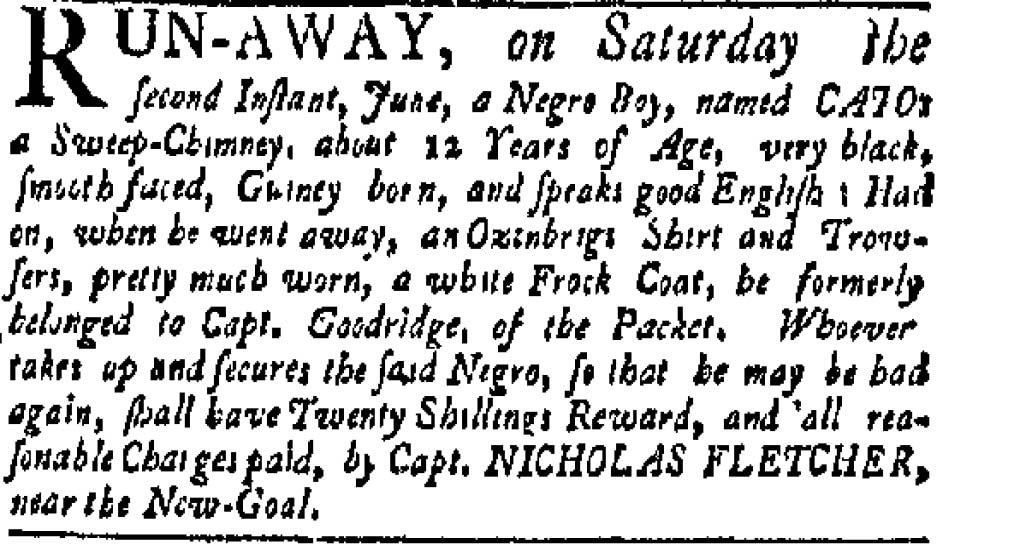
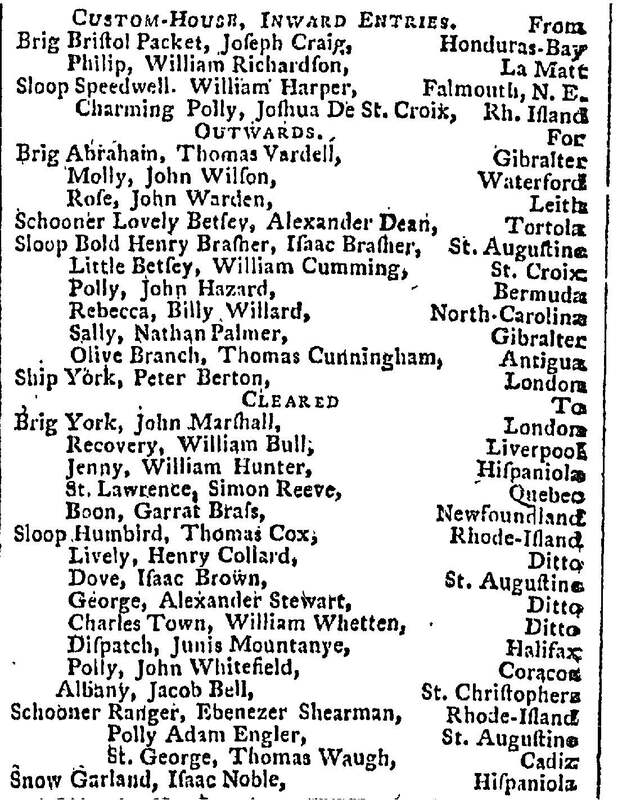
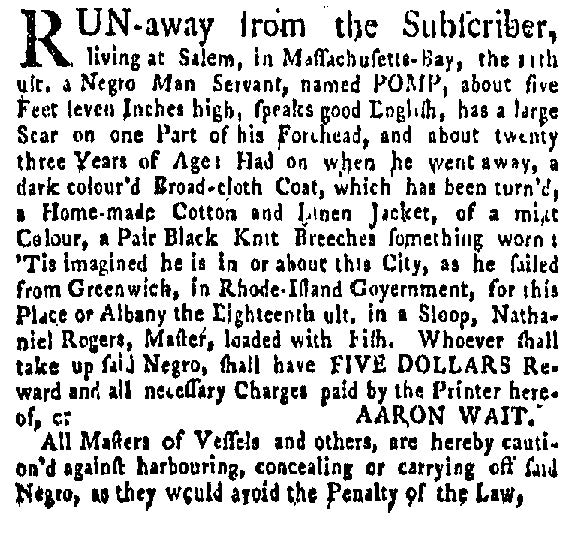

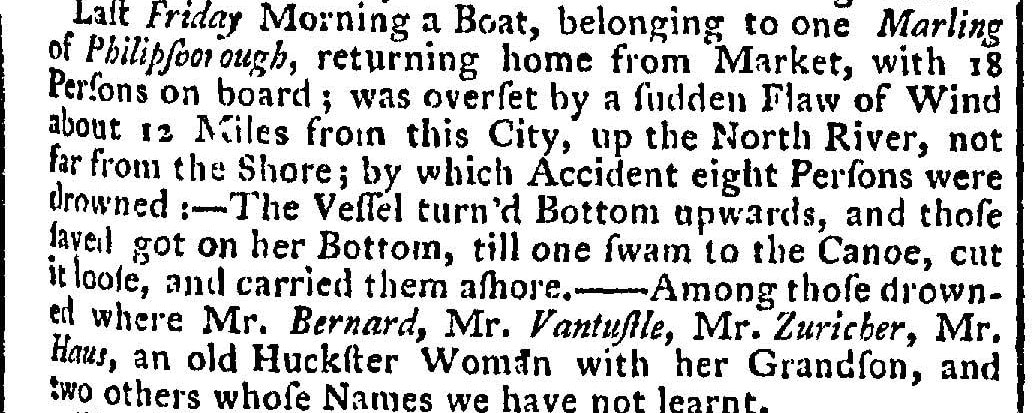
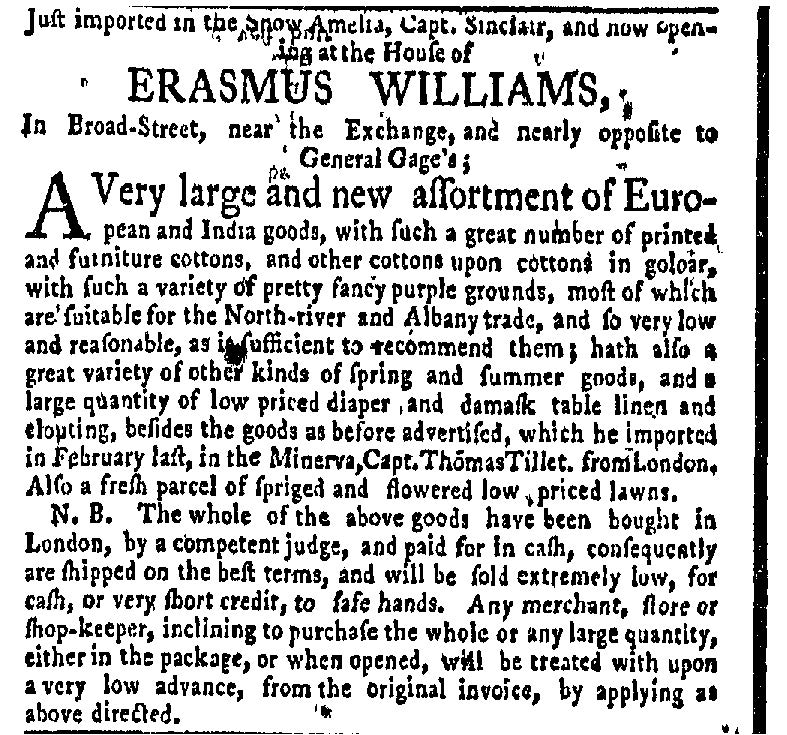
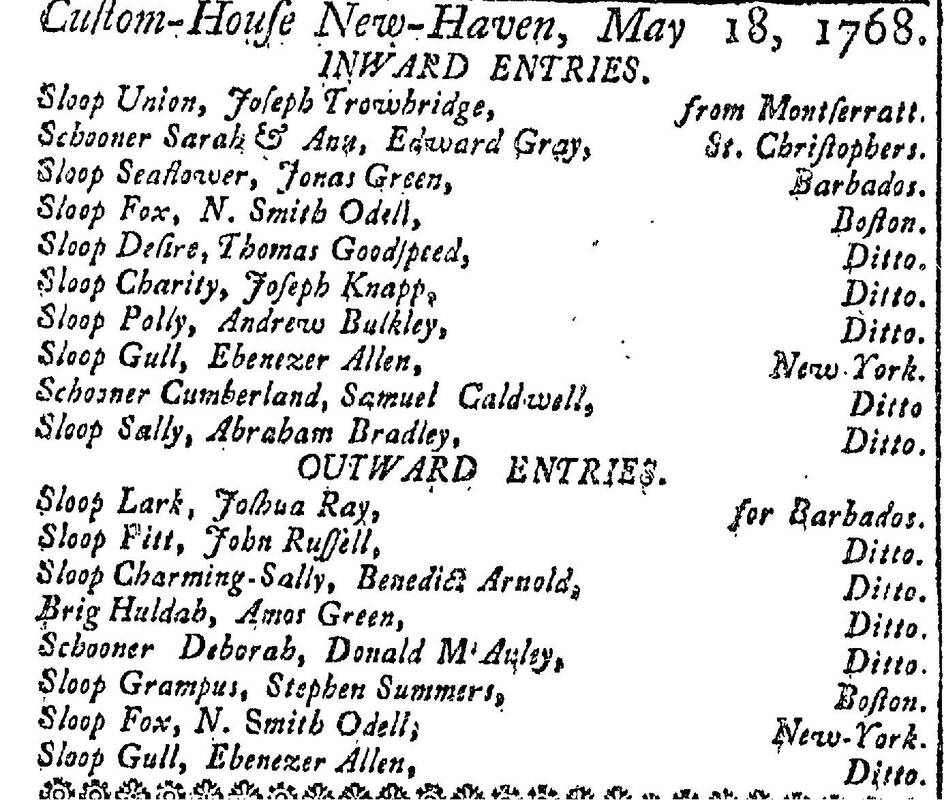

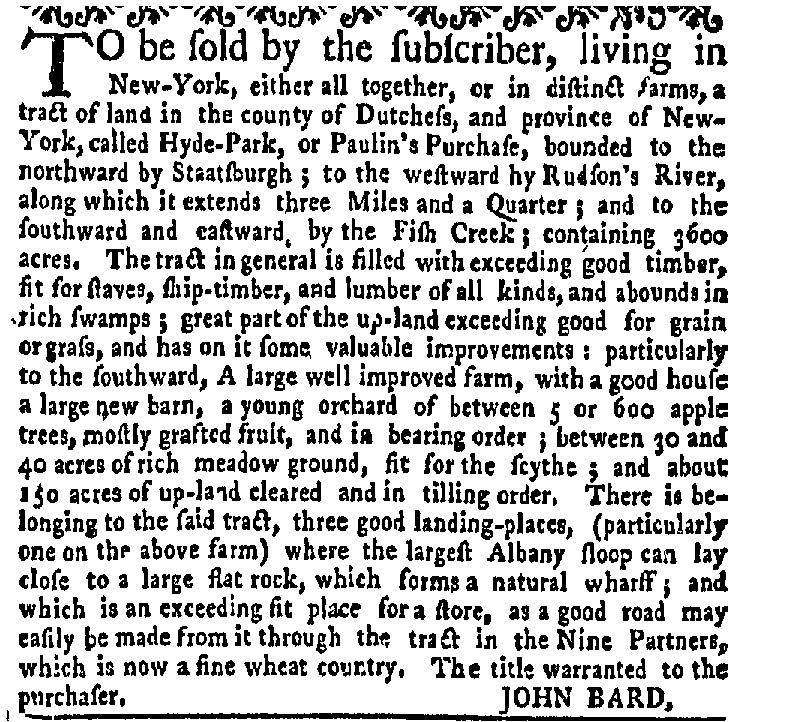
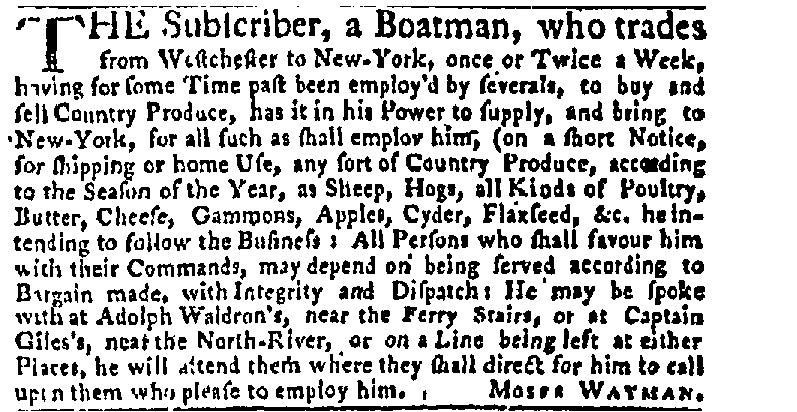
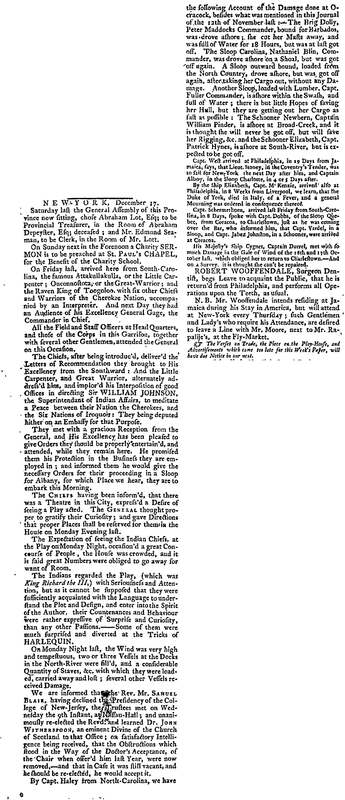
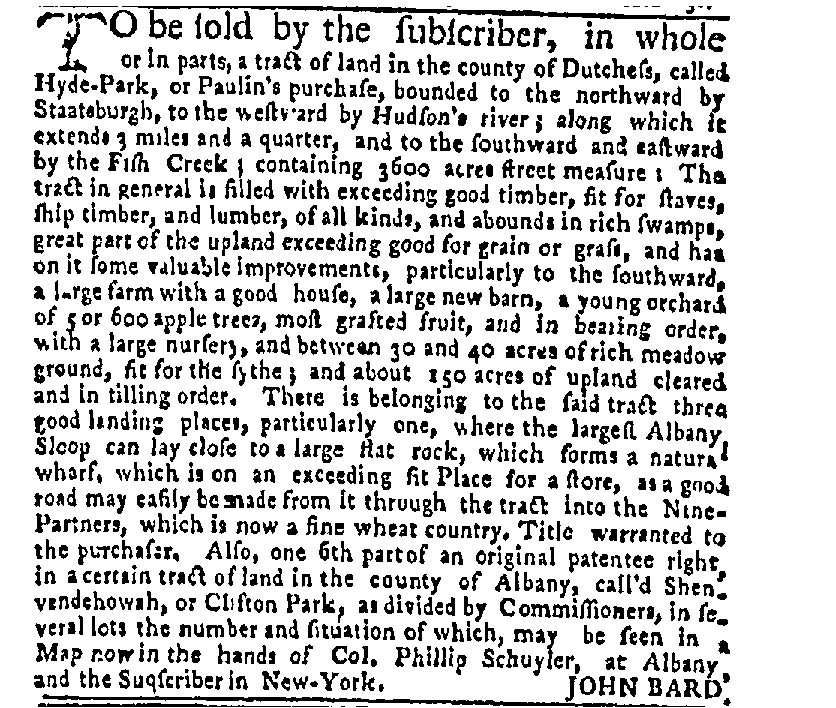
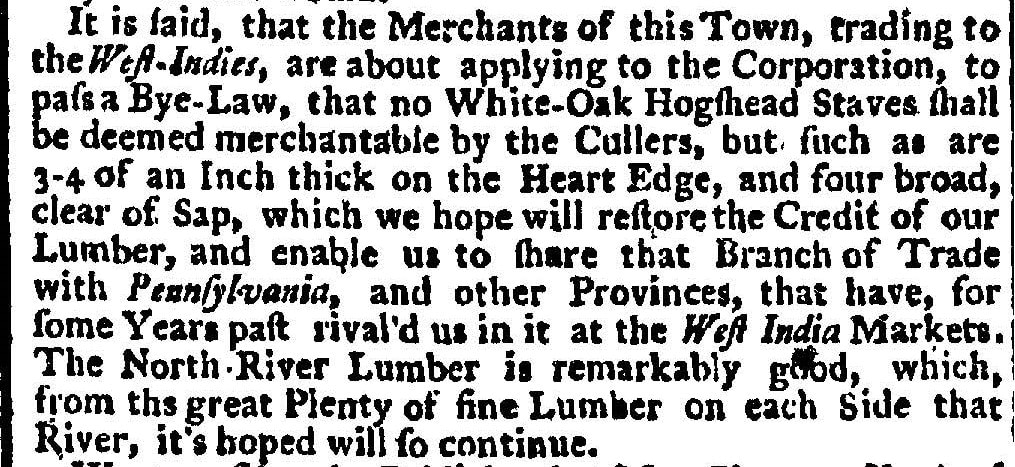
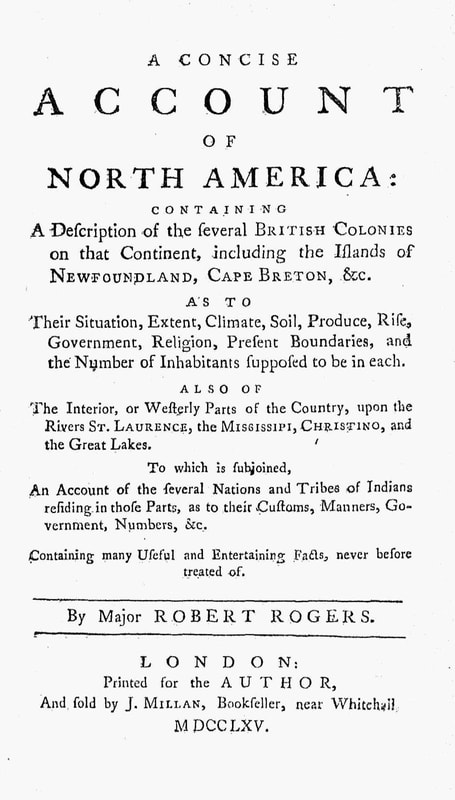
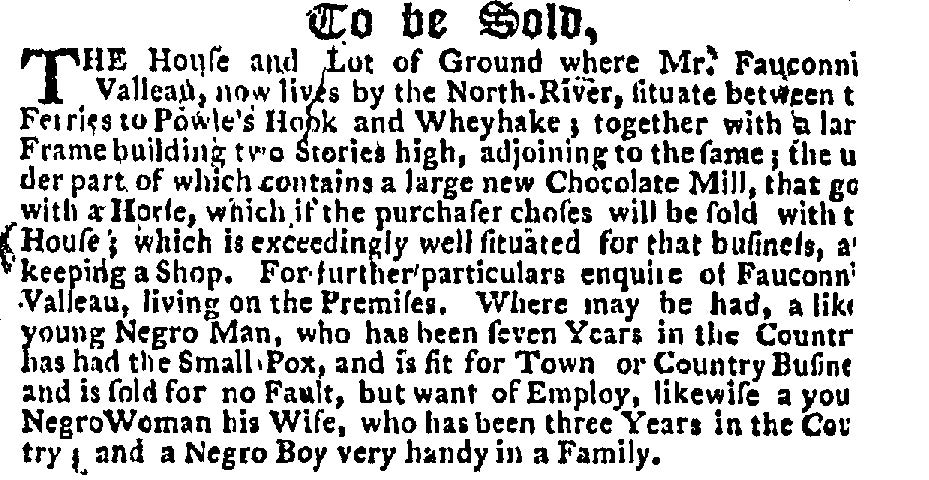
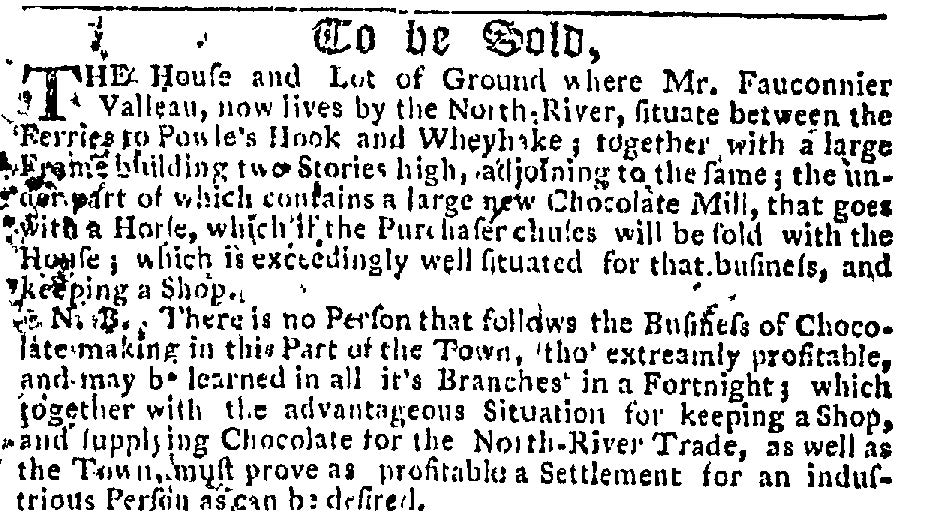

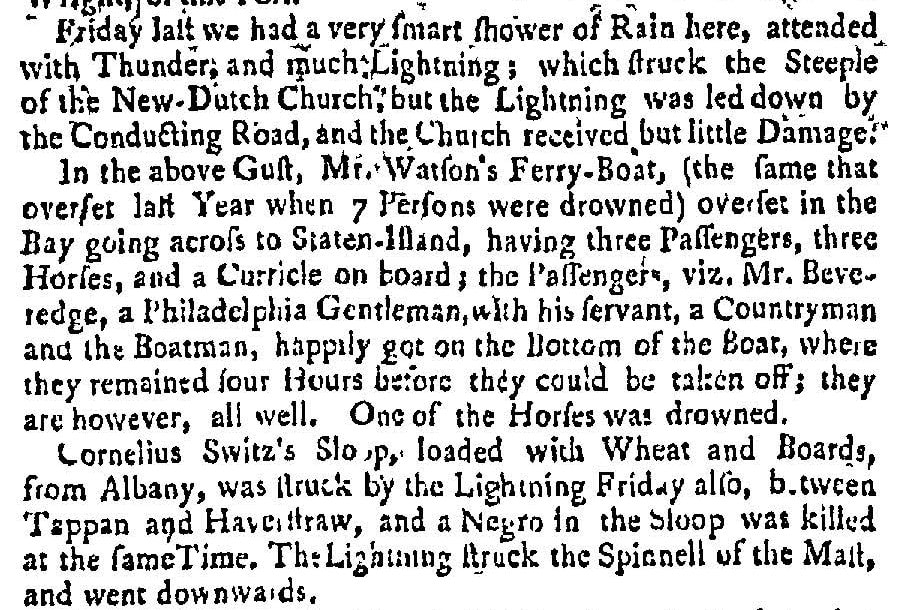
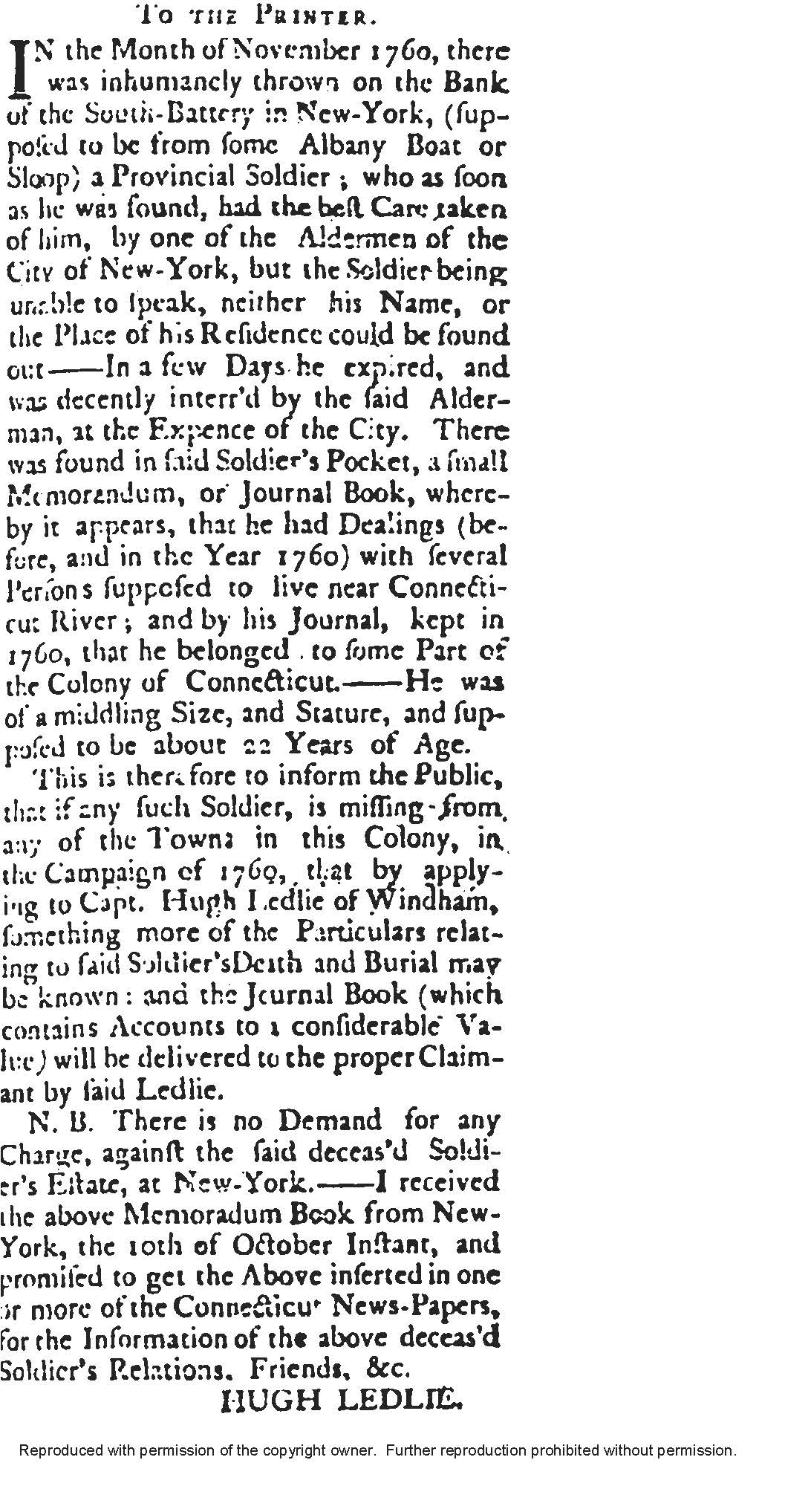

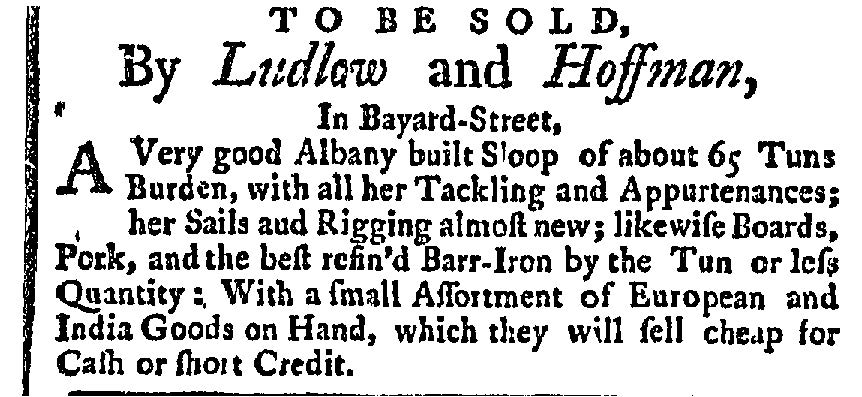
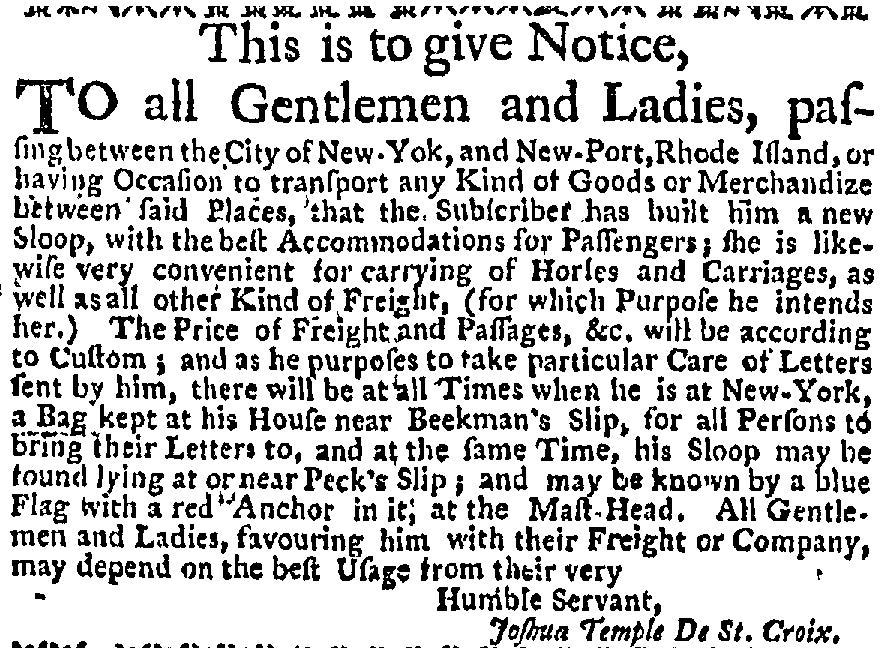
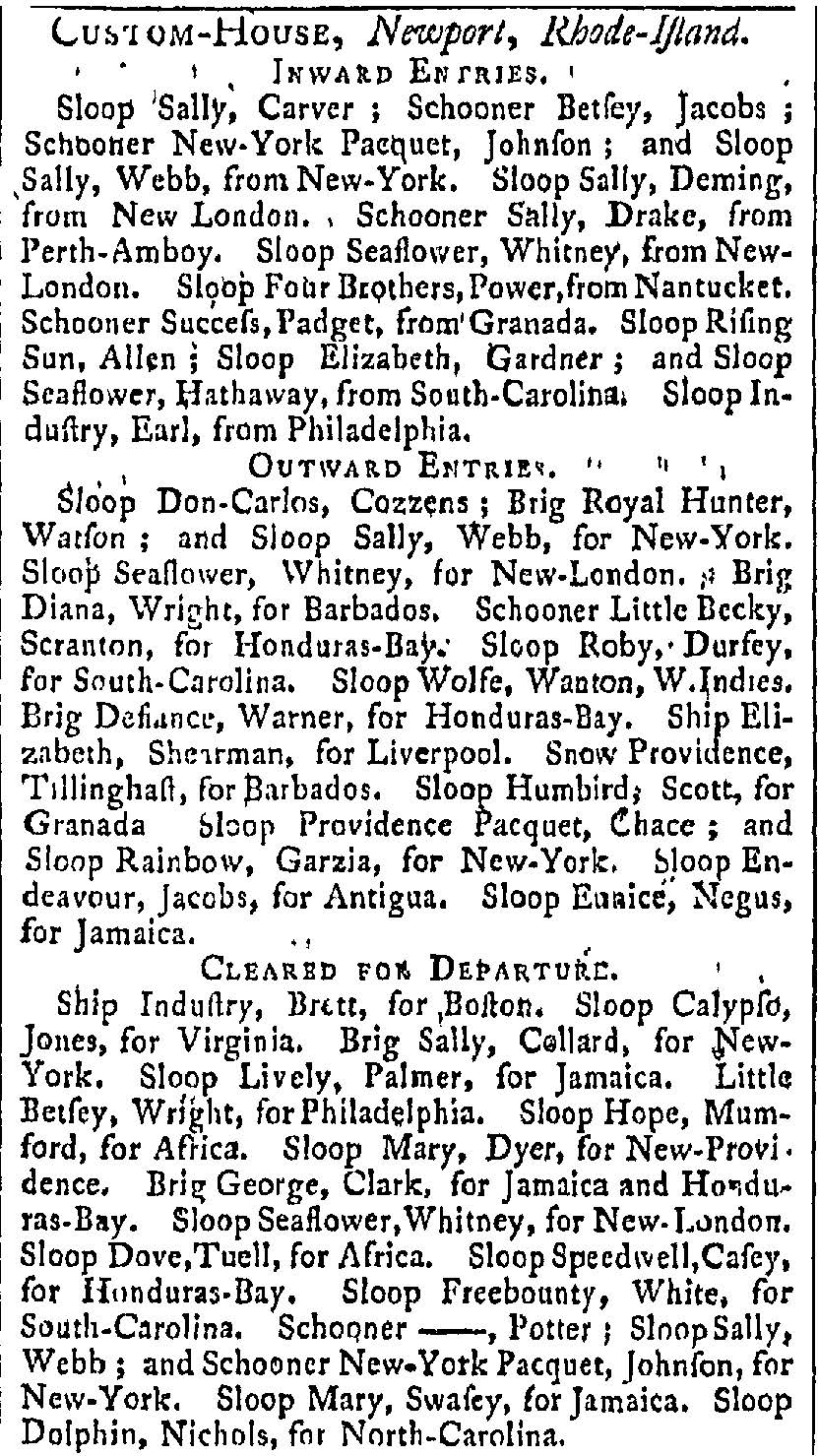

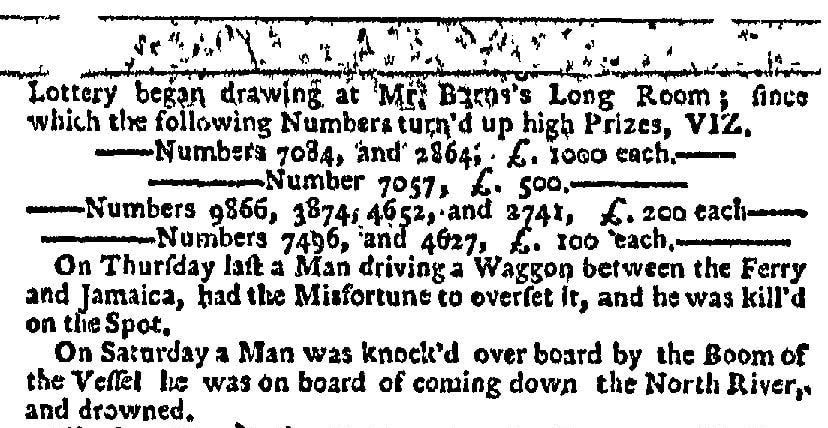


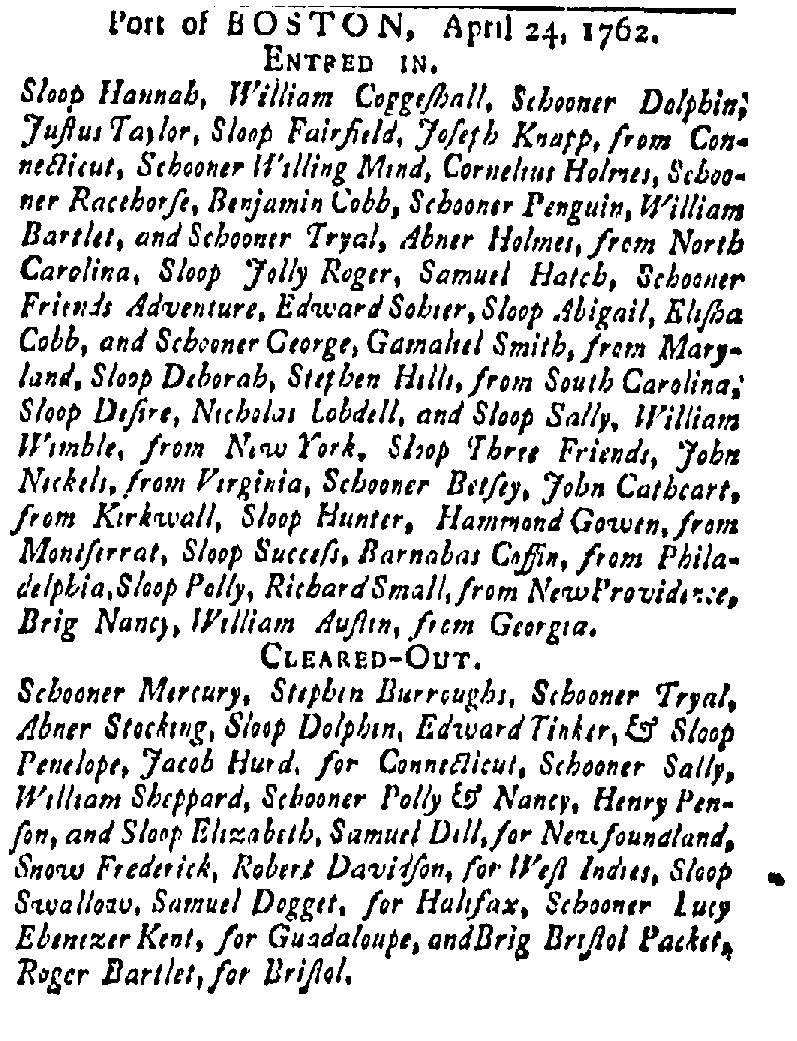
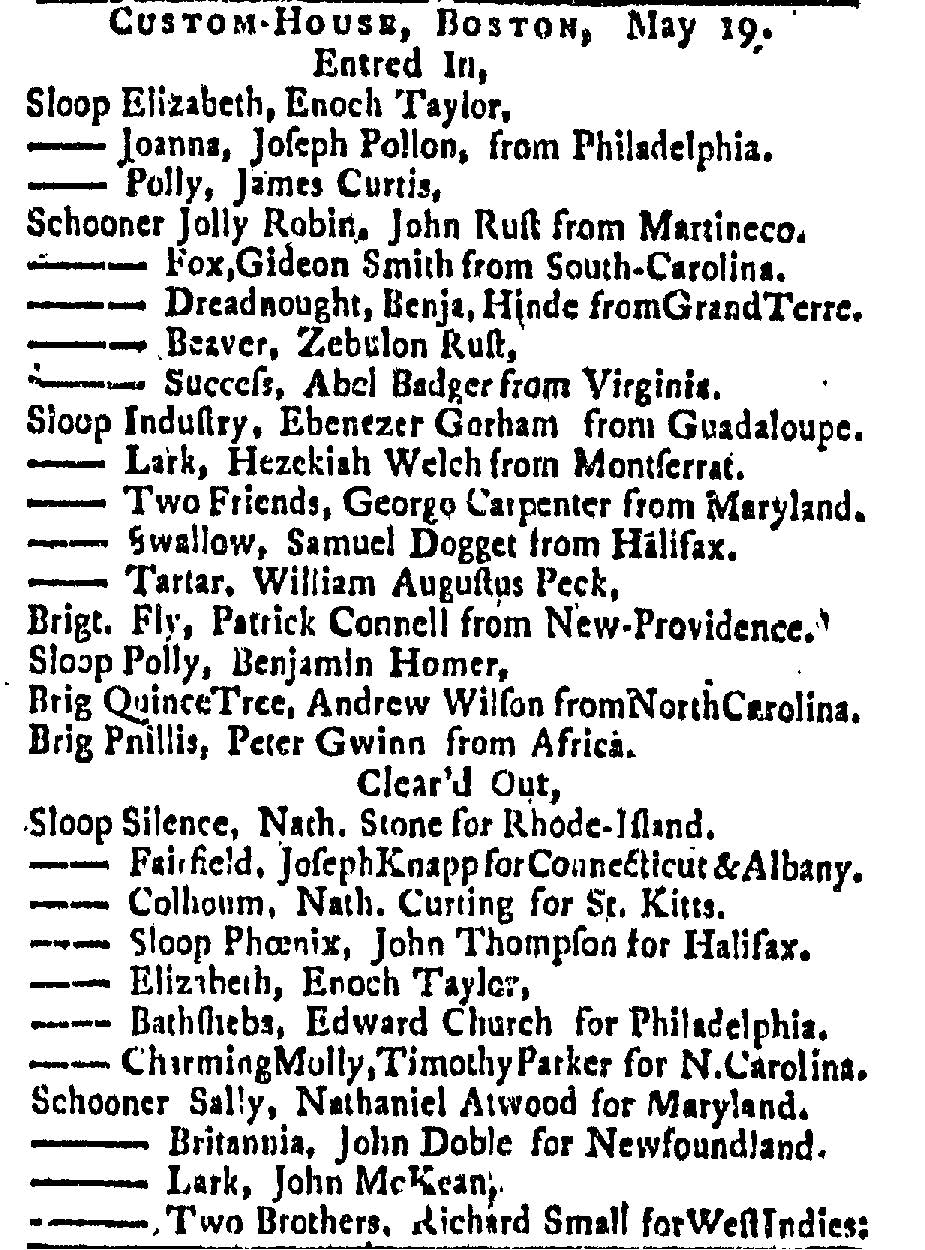
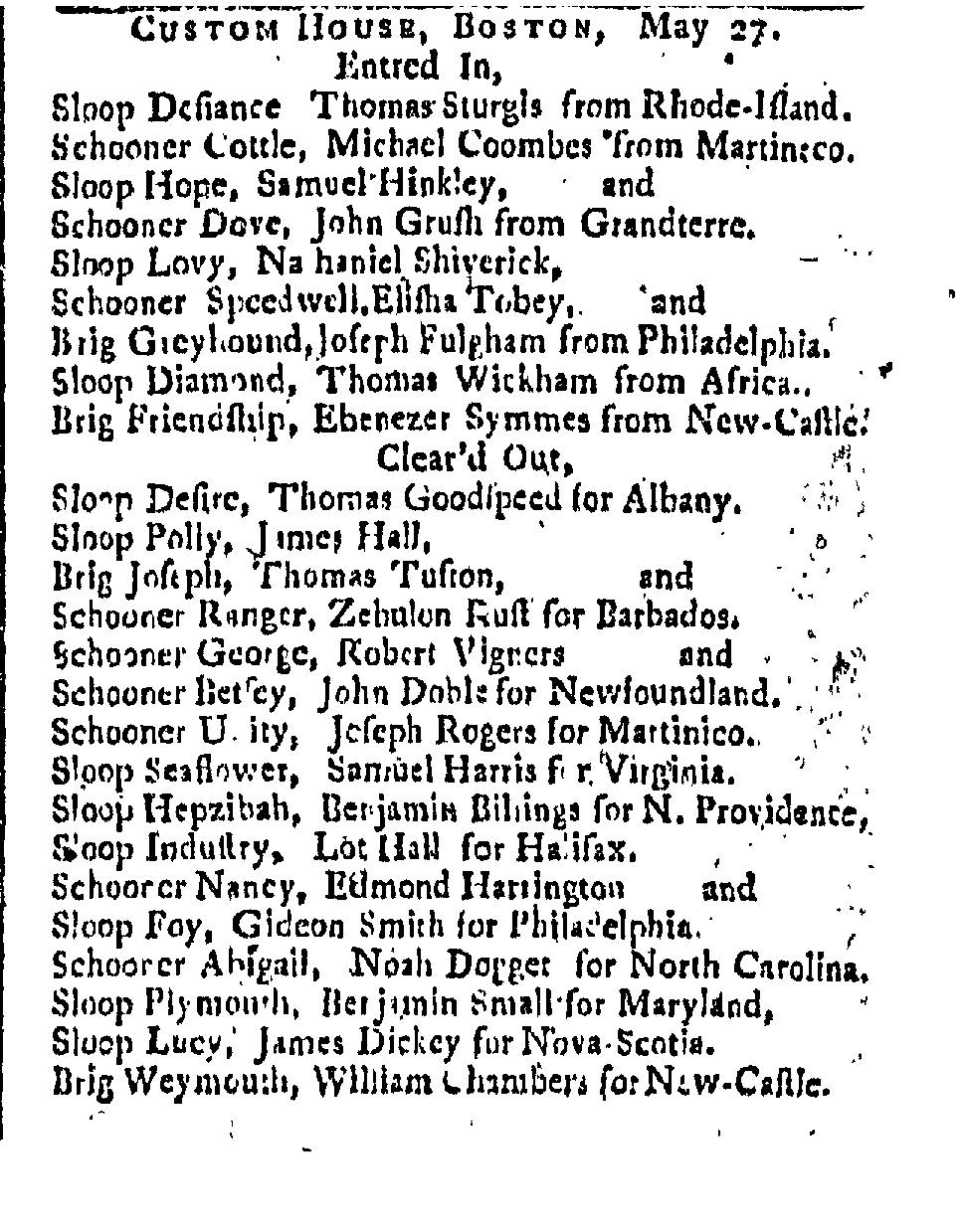
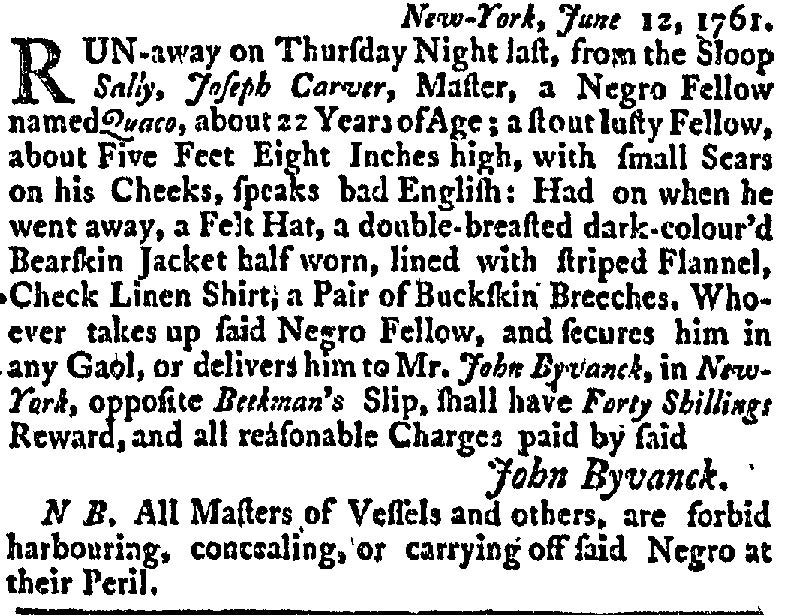
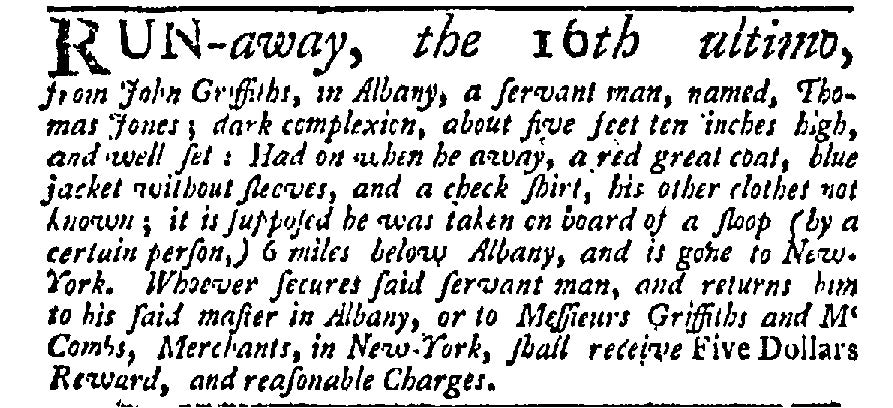

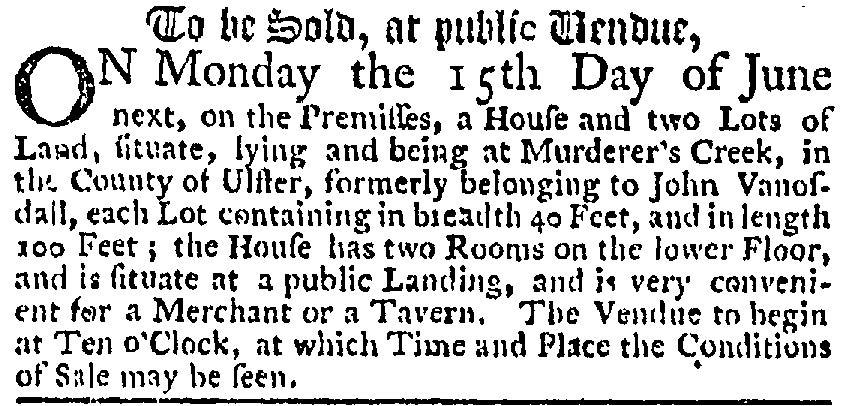
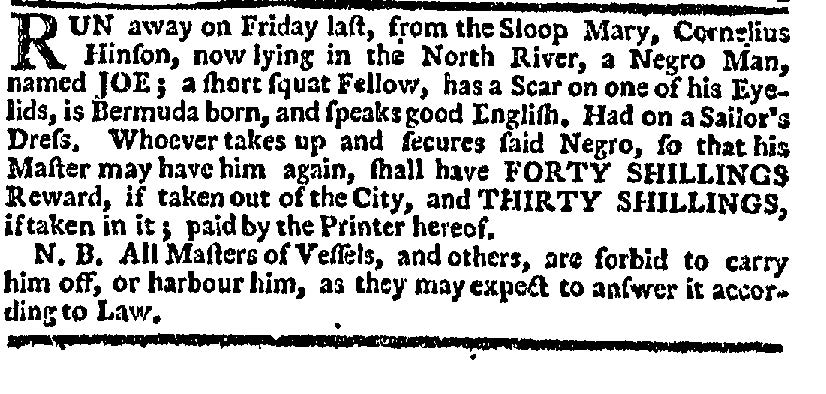
 RSS Feed
RSS Feed